Year
2018
12 entries in this year | view all years
Christmas Wish
Posted December 2018 in New Additions
“In the beginning was the Word, and the Word was with God, and the Word was God…And the Word became flesh and dwelt among us, and we beheld His glory, the glory as of the only begotten of the Father, full of grace and truth” (John 1:1,14)
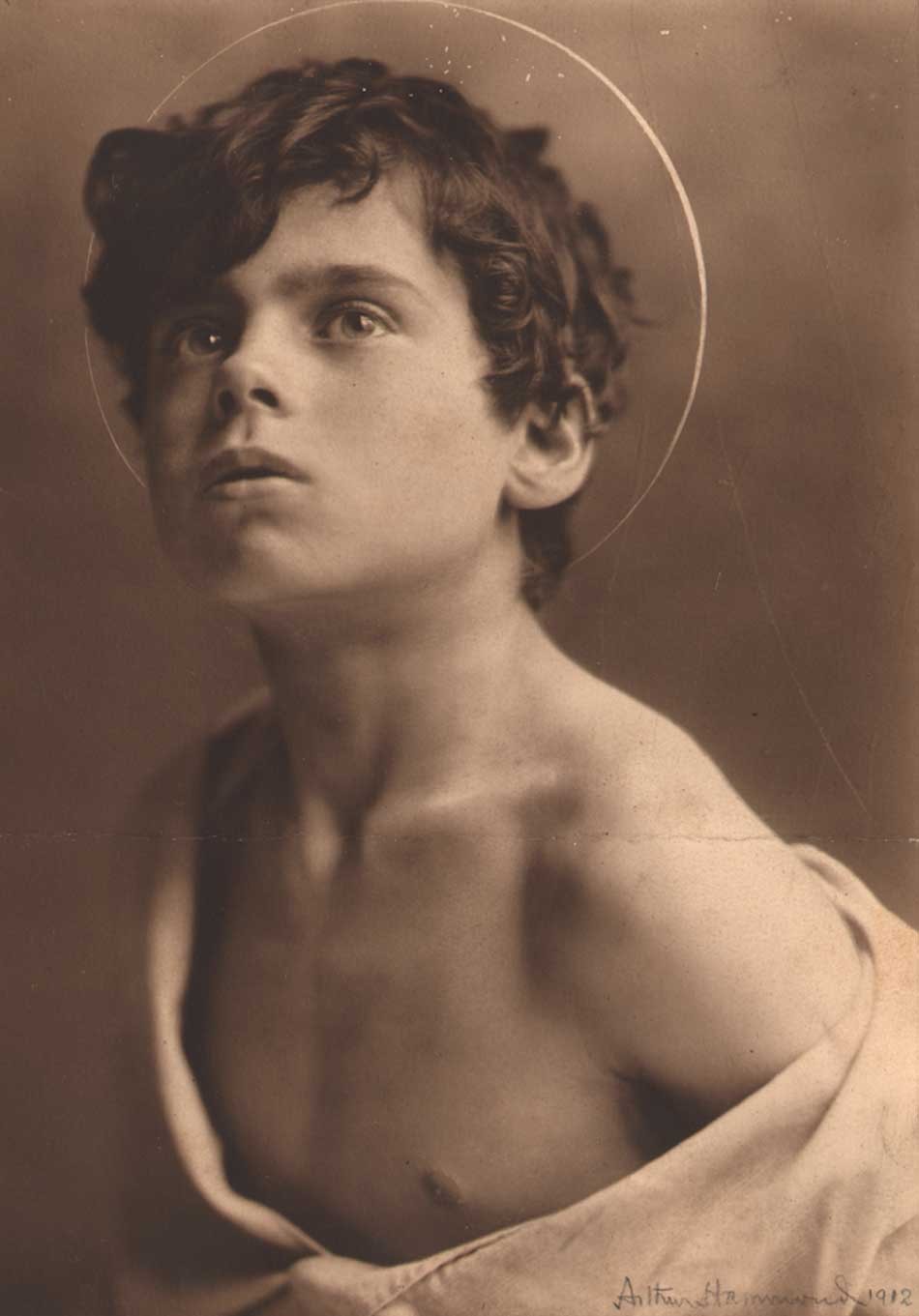 Detail: “St. John”: Arthur Hammond, American: born England:1880-1962: vintage bromide print mounted to album leaf, 1912: 20.8 x 15.6 | 25.0 x 32.7 cm. Dating from 1910 or slightly earlier, this portrayal of St. John the Apostle is represented by the haloed, allegorical form of a young child looking to heaven and dictating his Gospel to his disciple. From a personal album held by this archive of nearly 100 photographs attributed to Hammond dating ca. 1910-1940. Born in London, the artist arrived in America at Ellis Island on July 31, 1909 and established himself with his own studio outside Boston by 1912. In 1920, he authored the foundational book "Pictorial Composition in Photography”, in which this portrait served as the frontis. Hammond would go on to become a leading voice for pictorialism in America through his position as associate editor of American Photography magazine from 1918-1949. From: PhotoSeed Archive
Detail: “St. John”: Arthur Hammond, American: born England:1880-1962: vintage bromide print mounted to album leaf, 1912: 20.8 x 15.6 | 25.0 x 32.7 cm. Dating from 1910 or slightly earlier, this portrayal of St. John the Apostle is represented by the haloed, allegorical form of a young child looking to heaven and dictating his Gospel to his disciple. From a personal album held by this archive of nearly 100 photographs attributed to Hammond dating ca. 1910-1940. Born in London, the artist arrived in America at Ellis Island on July 31, 1909 and established himself with his own studio outside Boston by 1912. In 1920, he authored the foundational book "Pictorial Composition in Photography”, in which this portrait served as the frontis. Hammond would go on to become a leading voice for pictorialism in America through his position as associate editor of American Photography magazine from 1918-1949. From: PhotoSeed ArchiveFrom the Trenches a Century On
Posted November 2018 in Advertising, History of Photography, Photography, Significant Photographs, Unknown Photographers
For your consideration, we offer a happier vision of patriotic leanings supporting the home-front on this milestone day in history marking the end of World War 1.
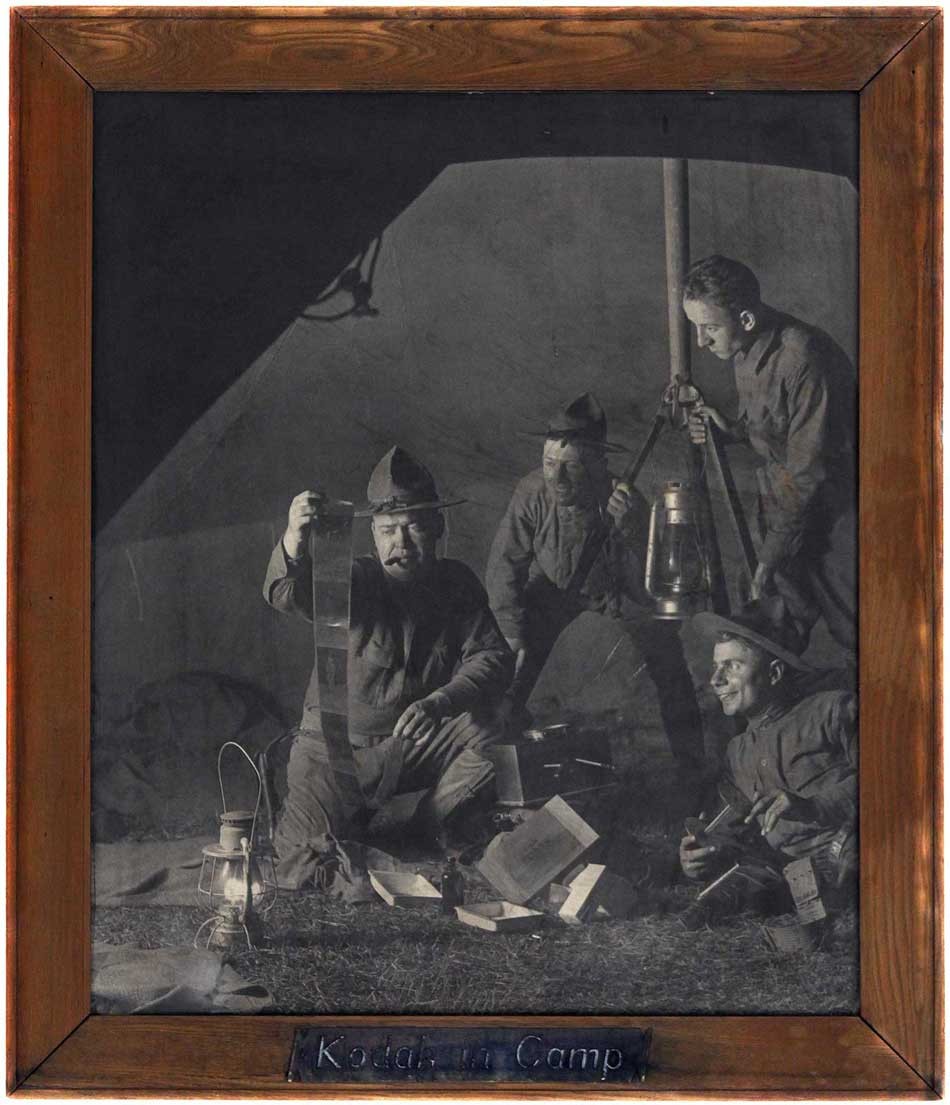 "Kodak in Camp": vintage framed bromide print ca. 1917 by unknown American photographer: Image Dimensions: 71.4 x 60.0 | cm 83.2 x 71.8 cm stained oak frame. This rare mammoth-sized Kodak advertising photograph featuring American “Doughboys” working together developing film in their tent at night was used by the Eastman company in their “Take a KODAK With You” advertising campaign. In late 1917, it appeared in publications including The Saturday Evening Post and The Independent (with which is incorporated Harpers Weekly) From: PhotoSeed Archive
"Kodak in Camp": vintage framed bromide print ca. 1917 by unknown American photographer: Image Dimensions: 71.4 x 60.0 | cm 83.2 x 71.8 cm stained oak frame. This rare mammoth-sized Kodak advertising photograph featuring American “Doughboys” working together developing film in their tent at night was used by the Eastman company in their “Take a KODAK With You” advertising campaign. In late 1917, it appeared in publications including The Saturday Evening Post and The Independent (with which is incorporated Harpers Weekly) From: PhotoSeed Archive
On the Eleventh Hour of the Eleventh Day of the Eleventh Month- November 11, 1918, the signing of the Armistice ending the Great War took place 60 kilometers north of Paris inside a railway carriage parked in the Forest of Compiègne. It has now been 100 years since that fateful day, on that fateful month and on that fateful hour. Sadly, mankind seems doomed to repeat his failures.
But a pivoting to Photography in relation to these weighty issues will always be of interest to the historian.
In 1914, the role of the medium expanded greatly at the outset of World War 1. In addition to photography’s new found power through smaller cameras to document unspeakable human suffering and death by the millions brought about by trench warfare, aerial reconnaissance photography gave countries the ability to monitor troop movements and to devise strategy in nearly real time. And then there was the home-front. The Eastman Kodak Company was certainly not going to let a war get in the way in order to call attention to their brand and sell more product.
Retooling like other large concerns in order to become an essential military contractor, they saw American Doughboys entering the war late in the conflict as brand ambassadors. As proof, the Kodak Vest Pocket camera, which debuted in 1912, found its’ way onto the front lines and trenches of many battlefields-legally or otherwise, and advertising posters hawking the camera as well as this oversized framed bromide print of soldiers for darkroom supplies and film called Kodak in Camp prominently appeared displayed in camera shops throughout the country.
And Kodak went further. As part of their national print advertising campaign dubbed “Take a KODAK with you”, this photo of nighttime developing in camp appeared full page in the pages of the Saturday Evening Post magazine for their August 4, 1917 issue as well as other publications around that time.
But most importantly, we honor the memory today of all the fallen. In a tribute to just one, a Scottish photographer by the name of Nichol Elliot, whose 1917 death in wartime Belgium is memorialized by a volume of his pictorial photographs accompanied by poems written by his wife Alice Elliot, we give her final stanza from An Idyll of Peace:
How swift from summer idylls came the wrench
Of life flung thence, by war and manhood’s will,
To battle roar and glare, or deathly chill
Of watch and warfare in the nightmare trench!
For peace divine man paid diviner price ⎯
In world-wide idyll of high sacrifice.
-Paired with Nichol Elliot photograph: In the Island, Toronto
For additional background on photography and the Great War, check out this New York Times Lens blog post from 2014.
Bluebeard Blues
Posted October 2018 in Alternate Processes, New Additions
Happy Halloween!
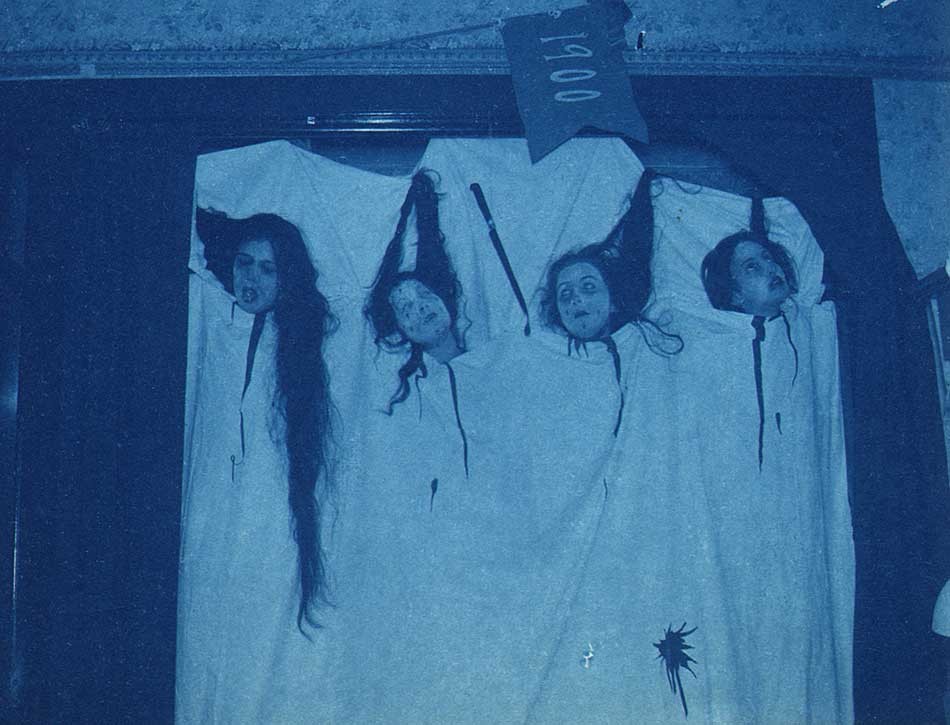 Detail: "Bluebeard's Wives" (Halloween, Tenney House at Smith College) Unknown American photographer: Cyanotype: ca. 1900 (7.4 x 9.6 cm | 18.2 x 27.5 cm loosely inserted within thin, manilla album leaf) During a Halloween party in Northampton, Massachusetts, Smith College students have some ghoulish fun portraying themselves as some of the decapitated wives done in by the hand of a French nobleman. This villain, known as Bluebeard, comes from the European folktale "Barbe bleue" first made famous by author Charles Perrault in 1697. Wikipedia says Bluebeard "tells the story of a wealthy violent man in the habit of murdering his wives and the attempts of one wife to avoid the fate of her predecessors. "The White Dove", "The Robber Bridegroom" and "Fitcher's Bird" (also called "Fowler's Fowl") are tales similar to "Bluebeard". From: PhotoSeed Archive
Detail: "Bluebeard's Wives" (Halloween, Tenney House at Smith College) Unknown American photographer: Cyanotype: ca. 1900 (7.4 x 9.6 cm | 18.2 x 27.5 cm loosely inserted within thin, manilla album leaf) During a Halloween party in Northampton, Massachusetts, Smith College students have some ghoulish fun portraying themselves as some of the decapitated wives done in by the hand of a French nobleman. This villain, known as Bluebeard, comes from the European folktale "Barbe bleue" first made famous by author Charles Perrault in 1697. Wikipedia says Bluebeard "tells the story of a wealthy violent man in the habit of murdering his wives and the attempts of one wife to avoid the fate of her predecessors. "The White Dove", "The Robber Bridegroom" and "Fitcher's Bird" (also called "Fowler's Fowl") are tales similar to "Bluebeard". From: PhotoSeed ArchiveGoodbye, Sagamore Farm
Posted October 2018 in Alternate Processes, Childhood Photography, New Additions, Painters|Photographers, Scientific Photography
I recently trekked to the New Hampshire seacoast to investigate the origins of two cyanotype photogram albums recently posted to this site. There, botanical specimens gathered by Helen Chase Gage when she was a child on her family’s country estate known as “Sagamore Farm” in Rye, New Hampshire were compiled during the summer months of 1929 and 1930.
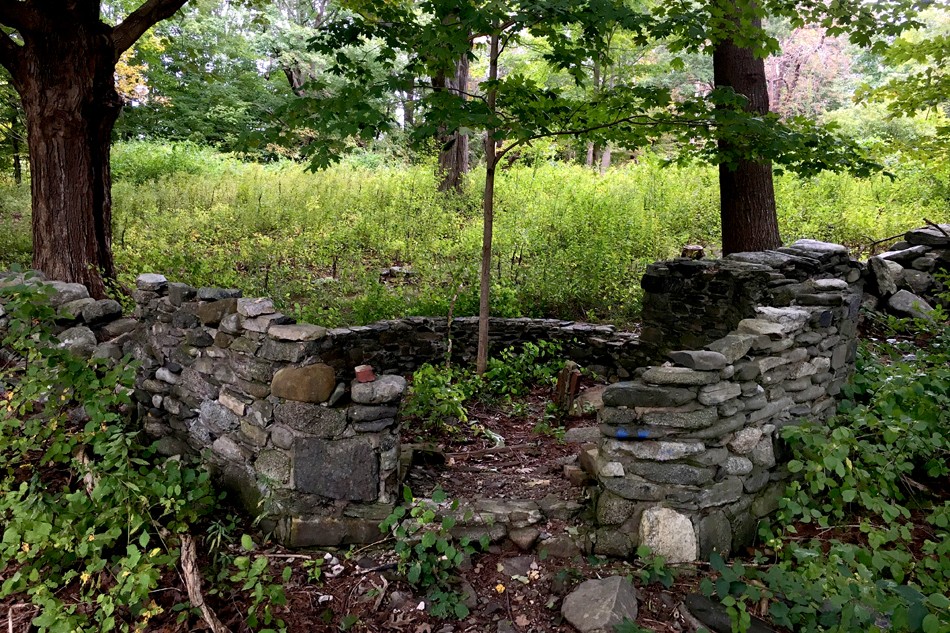 At Odiorne Point State Park in Rye, New Hampshire, remnants of foundation walls belonging to "Sagamore Farm" can be seen in this view looking west towards the seacoast photographed October 1, 2018. Helen Chase Gage (Miller) 1917-1982 was a schoolgirl when she roamed near here during the summers of 1929 & 1930 collecting botanical specimens used to make two albums of cyanotype photographs. The estate, a grand sixteen-room summer home built in 1892 by Dr. William Duncan McKim, (1855-1935) was purchased by Helen's parents in 1918 and eventually condemned and demolished by the US Federal Government in 1942 with other homes in order to build Fort Dearborn, which provided a coastal defense for the United States on the Atlantic seaboard during and after the World War II era. Photo by David Spencer for PhotoSeed Archive.
At Odiorne Point State Park in Rye, New Hampshire, remnants of foundation walls belonging to "Sagamore Farm" can be seen in this view looking west towards the seacoast photographed October 1, 2018. Helen Chase Gage (Miller) 1917-1982 was a schoolgirl when she roamed near here during the summers of 1929 & 1930 collecting botanical specimens used to make two albums of cyanotype photographs. The estate, a grand sixteen-room summer home built in 1892 by Dr. William Duncan McKim, (1855-1935) was purchased by Helen's parents in 1918 and eventually condemned and demolished by the US Federal Government in 1942 with other homes in order to build Fort Dearborn, which provided a coastal defense for the United States on the Atlantic seaboard during and after the World War II era. Photo by David Spencer for PhotoSeed Archive.
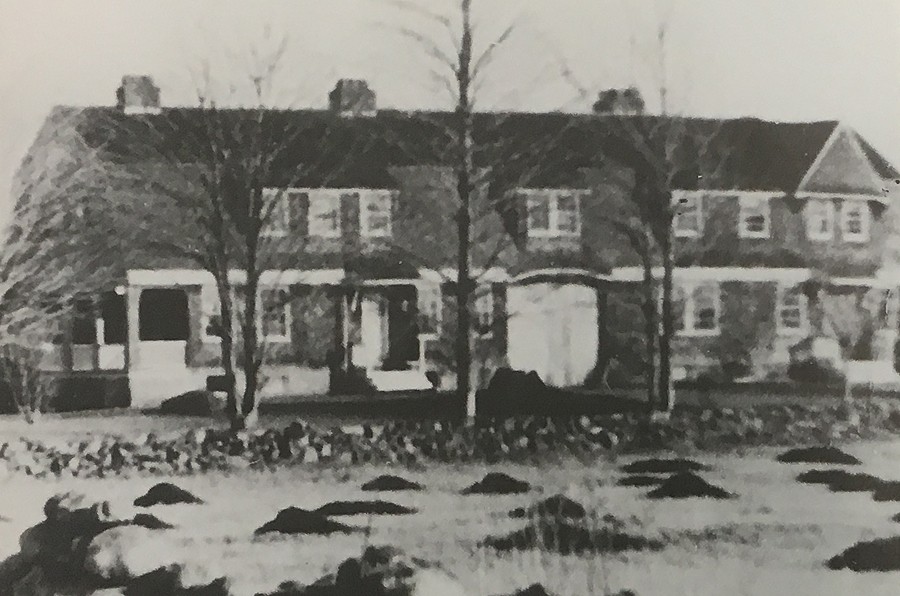 A surviving photograph of "Sagamore Farm" located in Rye New Hampshire, the summer country home where schoolgirl photographer Helen Chase Gage made her cyanotype albums during the summers of 1929-30. A sixteen-room home originally built in 1892 by Dr. William Duncan McKim, (1855-1935) it's described in the 1994 volume Footprints in Time: A Walk where New Hampshire Began as: "This was a large house with two matching sides separated by a porte cochere (a carriage drive-through) which went through the house to the large barn behind." Notice the stone wall in front of the home, indicating the presence of farm fields that criss-crossed the future Odiorne Point State Park property. Photo courtesy Seacoast Science Center.
A surviving photograph of "Sagamore Farm" located in Rye New Hampshire, the summer country home where schoolgirl photographer Helen Chase Gage made her cyanotype albums during the summers of 1929-30. A sixteen-room home originally built in 1892 by Dr. William Duncan McKim, (1855-1935) it's described in the 1994 volume Footprints in Time: A Walk where New Hampshire Began as: "This was a large house with two matching sides separated by a porte cochere (a carriage drive-through) which went through the house to the large barn behind." Notice the stone wall in front of the home, indicating the presence of farm fields that criss-crossed the future Odiorne Point State Park property. Photo courtesy Seacoast Science Center.
 "Sweet Alyssum" (Lobularia maritima) Helen Chase Gage- American: 1917-1982; Cyanotype: 1930: (18.0 x 12.9 | 21.6 x 14.6 cm) Inscribed on opposite album page: Sweet Alyssum Blue Print made August 17, 1930 At Sagamore Farm, N.H. By Helen C. Gage. From: PhotoSeed Archive
"Sweet Alyssum" (Lobularia maritima) Helen Chase Gage- American: 1917-1982; Cyanotype: 1930: (18.0 x 12.9 | 21.6 x 14.6 cm) Inscribed on opposite album page: Sweet Alyssum Blue Print made August 17, 1930 At Sagamore Farm, N.H. By Helen C. Gage. From: PhotoSeed Archive
Known today as Odiorne Point State Park, Helen’s family summer home was located on land at Frost Point at the mouth of the Piscataqua River and Gulf of Maine. In 1942 during World War II, the US federal government appropriated nearly 265 acres making up the future park boundaries through eminent domain, including the Sagamore Farm estate and other properties owned by 24 families. (11 homes are said to have been demolished) This was done in order to build Fort Dearborn, a coastal outpost manned by large gun emplacements designed to protect the nearby Portsmouth Naval Ship Yard on the Piscataqua.
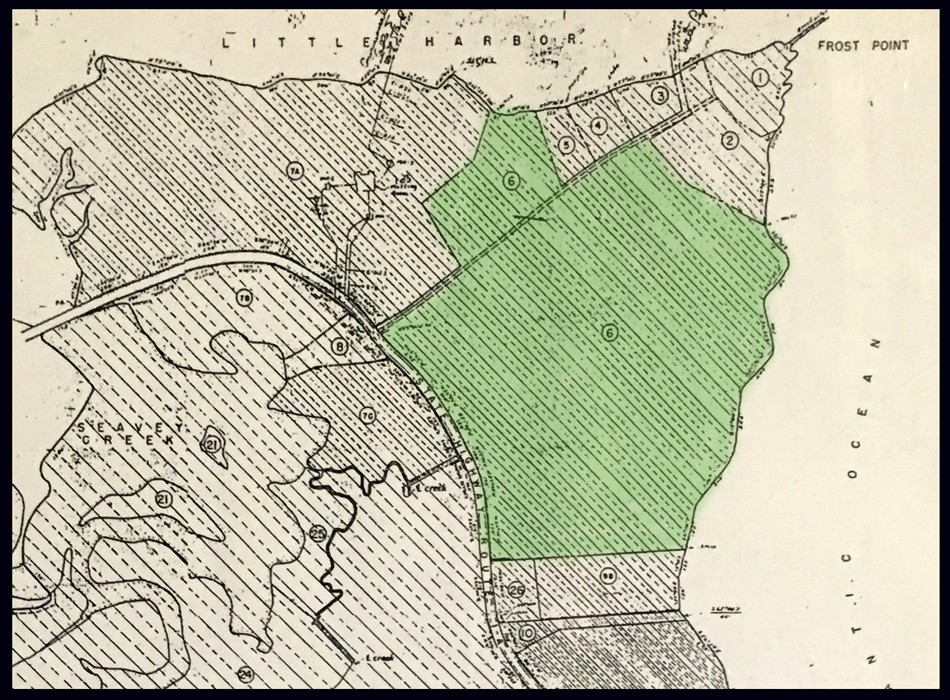 This ca. 1942 US War Department map shows the future area of Odiorne Point State Park in Rye, New Hampshire. Using the color green, this website has shaded the parcel belonging to photographer Helen Chase Gage's family- 43.6 acres. The US Government appropriated nearly 265 acres owned by 24 families through eminent domain in order to build Fort Dearborn, which took three years to complete. Graphic courtesy Seacoast Science Center.
This ca. 1942 US War Department map shows the future area of Odiorne Point State Park in Rye, New Hampshire. Using the color green, this website has shaded the parcel belonging to photographer Helen Chase Gage's family- 43.6 acres. The US Government appropriated nearly 265 acres owned by 24 families through eminent domain in order to build Fort Dearborn, which took three years to complete. Graphic courtesy Seacoast Science Center.
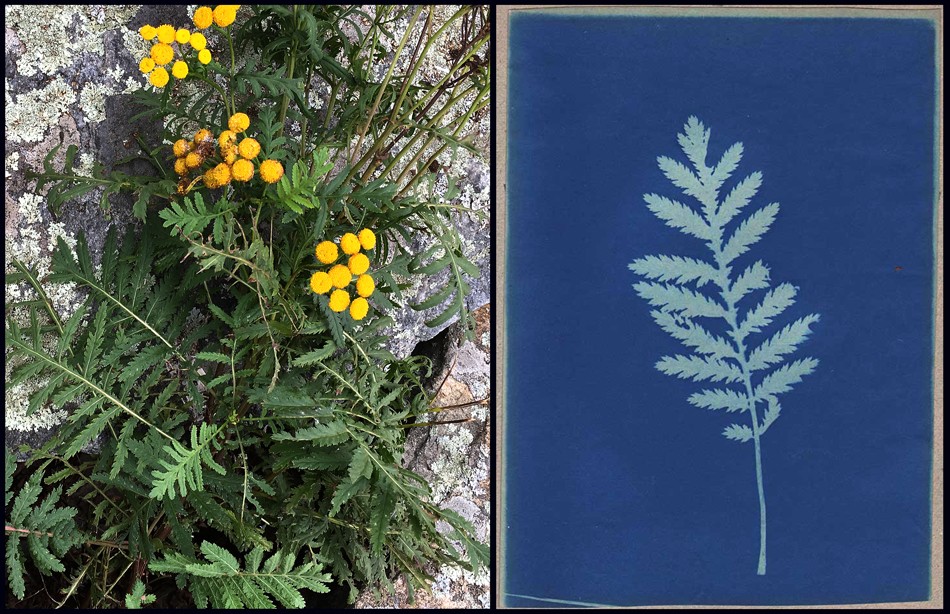 Left: Tansy flowers in bloom at Odiorne Point State Park in Rye, New Hampshire photographed October 1, 2018. Photo by David Spencer for PhotoSeed Archive. Right: "Tansy" (Tanacetum vulgare) Helen Chase Gage- American: 1917-1982; Cyanotype: 1929: (17.6 x 12.5 | 30.0 x 22.8 cm) Inscribed on same album page: Tansy: Blue Print made on July 17, 1929 at Sagamore Farm By Helen C. Gage. From: PhotoSeed Archive
Left: Tansy flowers in bloom at Odiorne Point State Park in Rye, New Hampshire photographed October 1, 2018. Photo by David Spencer for PhotoSeed Archive. Right: "Tansy" (Tanacetum vulgare) Helen Chase Gage- American: 1917-1982; Cyanotype: 1929: (17.6 x 12.5 | 30.0 x 22.8 cm) Inscribed on same album page: Tansy: Blue Print made on July 17, 1929 at Sagamore Farm By Helen C. Gage. From: PhotoSeed Archive
 This granite marker on the coastline at Odiorne Point State Park marks the location in the Spring of 1623 where English immigrant David Thomson (1593-1628) of Plymouth, England established the first European settlement on land that would become the future American state of New Hampshire. Originally installed in 1899, the marker was eventually moved but re-installed and re-dedicated in its' original spot in 2007: "Here Landed In the Spring of 1623 The First Band of Englishmen. Pioneers in The Planting of New Hampshire. Consecrating This Soil to The Service of God and Liberty. Photographed on October 1, 2018 by David Spencer for PhotoSeed Archive.
This granite marker on the coastline at Odiorne Point State Park marks the location in the Spring of 1623 where English immigrant David Thomson (1593-1628) of Plymouth, England established the first European settlement on land that would become the future American state of New Hampshire. Originally installed in 1899, the marker was eventually moved but re-installed and re-dedicated in its' original spot in 2007: "Here Landed In the Spring of 1623 The First Band of Englishmen. Pioneers in The Planting of New Hampshire. Consecrating This Soil to The Service of God and Liberty. Photographed on October 1, 2018 by David Spencer for PhotoSeed Archive.The area is rich in American history: at Odiorne Point within the present-day state park, a large granite marker (installed 1899 |rededicated 2007) marks the location in the Spring of 1623 where English immigrant David Thomson (1593-1628) of Plymouth, England established the first European settlement on land that would become the future American state of New Hampshire.
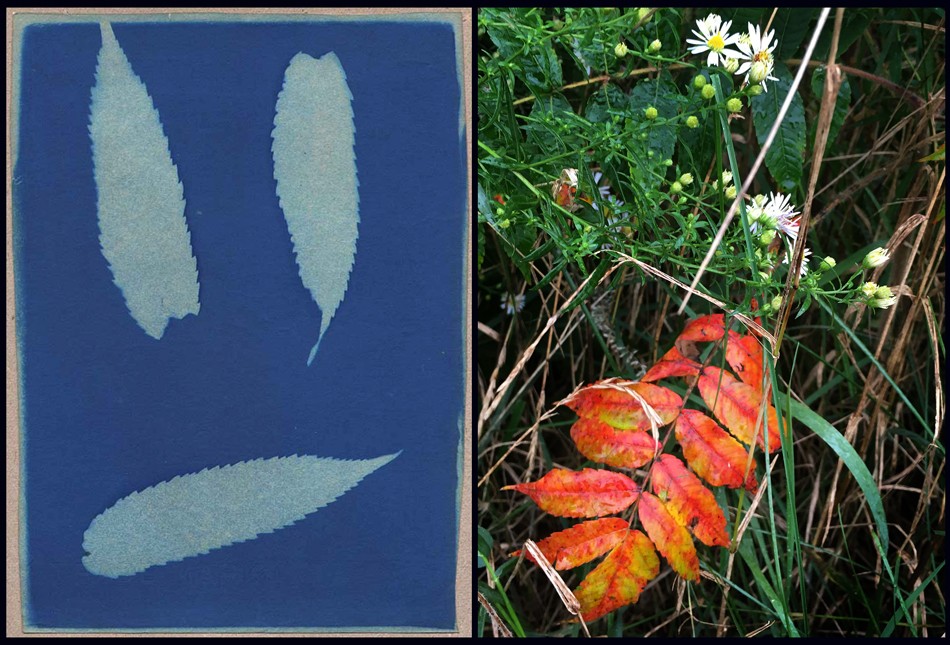 Left: "Sumack" (Rhus coriaria?) Helen Chase Gage- American: 1917-1982; Cyanotype: 1929: (18.0 x 13.0 cm | 21.6 x 14.6 cm) Inscribed on album page: Sumack: Blue Print made on July 23, 1929 at Sagamore Farm By Helen C. Gage. From: PhotoSeed Archive. Right: Sumac leaves from a shrub showing off their fall colors at Odiorne Point State Park in Rye, New Hampshire photographed October 1, 2018. Photo by David Spencer for PhotoSeed Archive.
Left: "Sumack" (Rhus coriaria?) Helen Chase Gage- American: 1917-1982; Cyanotype: 1929: (18.0 x 13.0 cm | 21.6 x 14.6 cm) Inscribed on album page: Sumack: Blue Print made on July 23, 1929 at Sagamore Farm By Helen C. Gage. From: PhotoSeed Archive. Right: Sumac leaves from a shrub showing off their fall colors at Odiorne Point State Park in Rye, New Hampshire photographed October 1, 2018. Photo by David Spencer for PhotoSeed Archive.
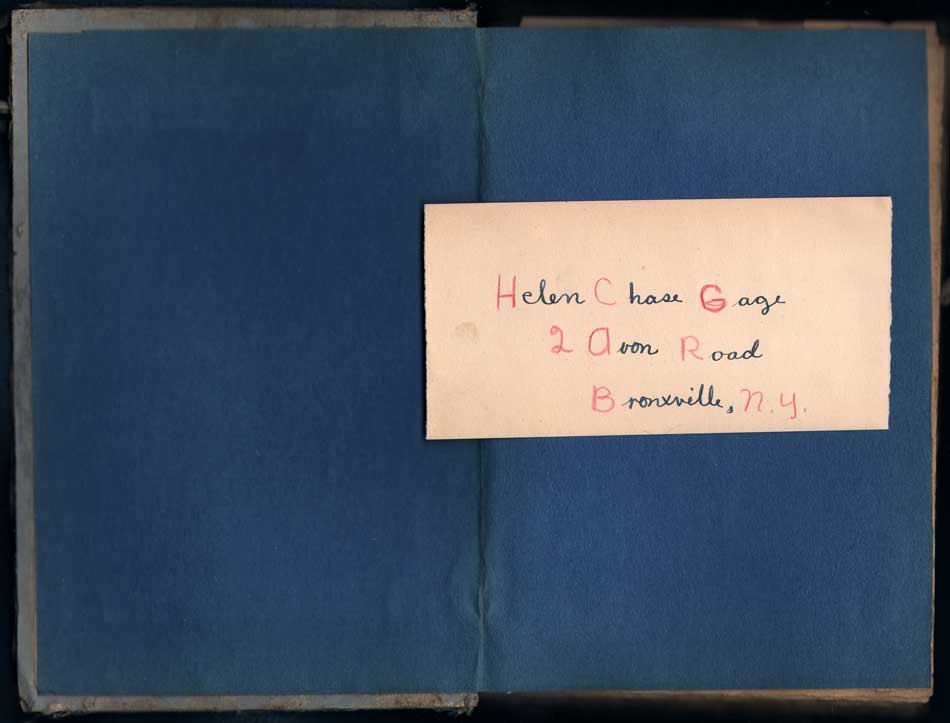 Helen Chase Gage hand-drawn calling card inserted within 1930 Blue Print album of botanical specimen photograms: Helen Chase Gage- American: 1917-1982: This hand-made album is shown opened with the front pastedown made from blue art paper extending full width of opened volume. Overall dimensions: 23.0 x 30.0 cm : Calling card: 7.6 x 15.1 cm. Helen Chase Gage spent her early childhood at 2 Avon Road in Bronxville, New York but assembled this album and another in 1929 at Sagamore Farm in Rye, New Hampshire. From: PhotoSeed Archive
Helen Chase Gage hand-drawn calling card inserted within 1930 Blue Print album of botanical specimen photograms: Helen Chase Gage- American: 1917-1982: This hand-made album is shown opened with the front pastedown made from blue art paper extending full width of opened volume. Overall dimensions: 23.0 x 30.0 cm : Calling card: 7.6 x 15.1 cm. Helen Chase Gage spent her early childhood at 2 Avon Road in Bronxville, New York but assembled this album and another in 1929 at Sagamore Farm in Rye, New Hampshire. From: PhotoSeed Archive
 "Larkspur" (Scientific name: Delphinium; Family: Ranunculaceae) Helen Chase Gage- American: 1917-1982; Cyanotype: 1930: (17.7 x 12.6 cm | 21.6 x 14.6 cm x2) Inscribed on opposite album page: Larkspur: Blue Print made August 10, 1930 At Sagamore Farm By Helen C. Gage. This representative album spread from Helen's 1930 collected cyanotypes is unusual because the original collected botanical specimens are featured as part of the volume. Thirty-one individual prints are included within the album closed by means of cloth ties, seen at far right of frame. From: PhotoSeed Archive
"Larkspur" (Scientific name: Delphinium; Family: Ranunculaceae) Helen Chase Gage- American: 1917-1982; Cyanotype: 1930: (17.7 x 12.6 cm | 21.6 x 14.6 cm x2) Inscribed on opposite album page: Larkspur: Blue Print made August 10, 1930 At Sagamore Farm By Helen C. Gage. This representative album spread from Helen's 1930 collected cyanotypes is unusual because the original collected botanical specimens are featured as part of the volume. Thirty-one individual prints are included within the album closed by means of cloth ties, seen at far right of frame. From: PhotoSeed Archive
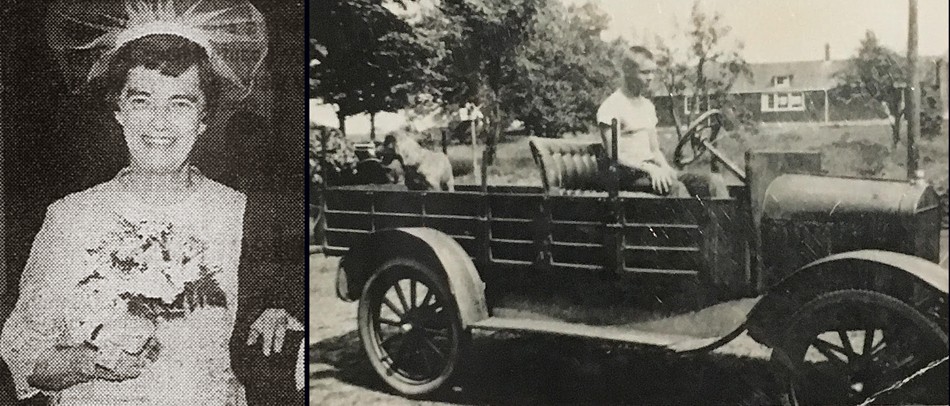 "Big Sister, Little Brother" Left: This cropped photograph of Helen Chase Gage Miller accompanied her 1970 wedding announcement in the Bronxville (New York) Review Press and Reporter newspaper. A graduate of Bronxville High School and Pratt Institute in Brooklyn earlier in life, she also attended Ursinus College. Later, the young photographer is known to have worked at Lord and Taylor, a department store in New York City, and was a member of the Reformed Church in Bronxville, the Anne Hutchinson Chapter of the Daughters of the American Revolution and the League for Service. Right: In 1935, Helen's younger brother Edward Augustus Gage (1919-2007) is shown behind the wheel of a 1918 Model T Ford depot wagon, along with his dog Ski at rear, in a photograph believed to have been taken near the family's summer property in Rye. The caption for this photograph which appeared in the volume "Footprints in Time" states: "Edward Gage later played an important role in trying to get the government to sell Odiorne land back to its pre-war owners." His 2007 obituary mentions he was a pilot and flight instructor in World War II and finished in the Naval Reserves at the rank of lieutenant commander. Trained as a lawyer, in 1970 he was appointed to serve as judge of the Exeter District Court in New Hampshire until his retirement in 2003. Photo courtesy Seacoast Science Center.
"Big Sister, Little Brother" Left: This cropped photograph of Helen Chase Gage Miller accompanied her 1970 wedding announcement in the Bronxville (New York) Review Press and Reporter newspaper. A graduate of Bronxville High School and Pratt Institute in Brooklyn earlier in life, she also attended Ursinus College. Later, the young photographer is known to have worked at Lord and Taylor, a department store in New York City, and was a member of the Reformed Church in Bronxville, the Anne Hutchinson Chapter of the Daughters of the American Revolution and the League for Service. Right: In 1935, Helen's younger brother Edward Augustus Gage (1919-2007) is shown behind the wheel of a 1918 Model T Ford depot wagon, along with his dog Ski at rear, in a photograph believed to have been taken near the family's summer property in Rye. The caption for this photograph which appeared in the volume "Footprints in Time" states: "Edward Gage later played an important role in trying to get the government to sell Odiorne land back to its pre-war owners." His 2007 obituary mentions he was a pilot and flight instructor in World War II and finished in the Naval Reserves at the rank of lieutenant commander. Trained as a lawyer, in 1970 he was appointed to serve as judge of the Exeter District Court in New Hampshire until his retirement in 2003. Photo courtesy Seacoast Science Center.
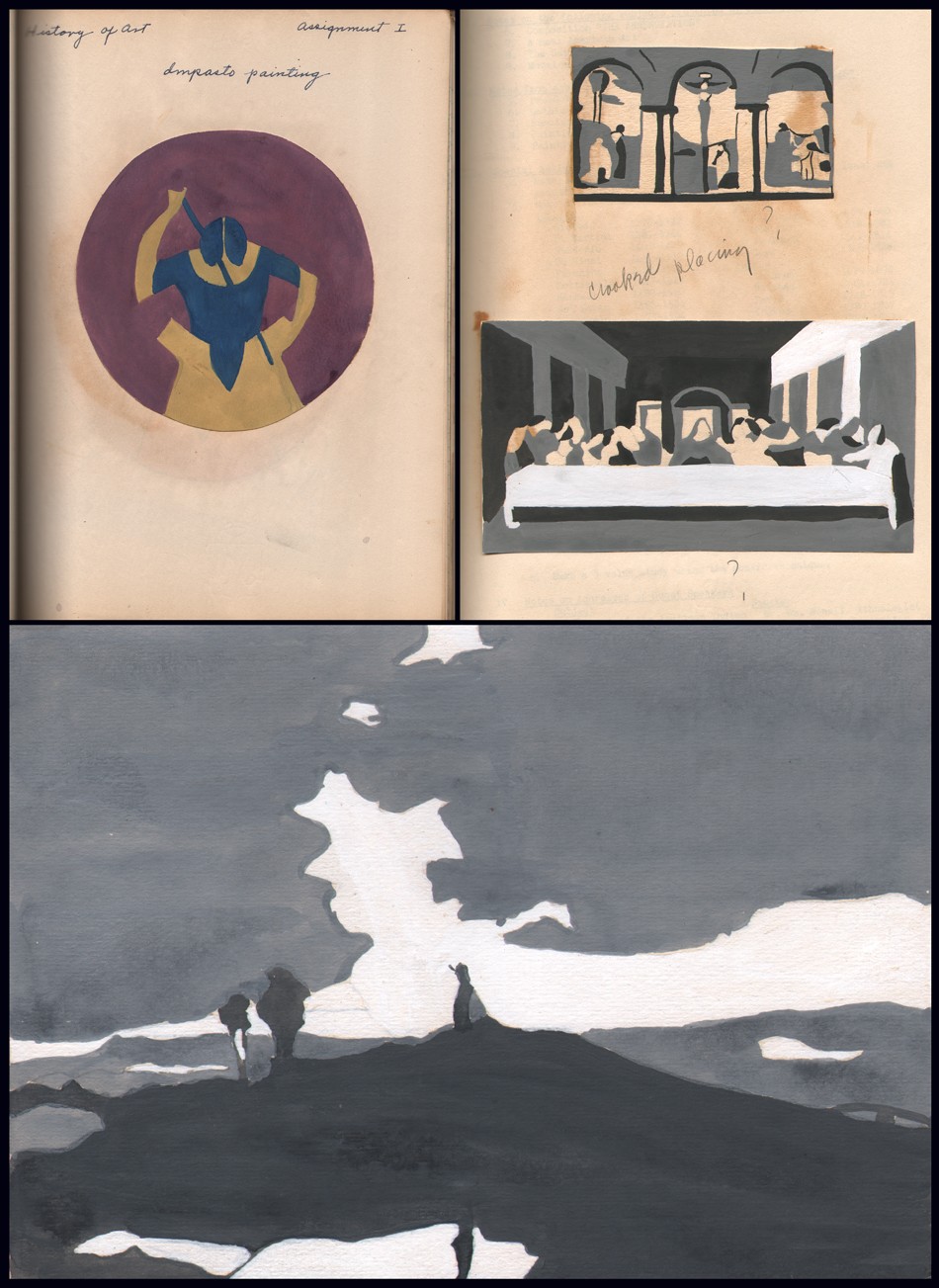 The pursuit of art was evident for Helen Chase Gage after early childhood. Although it's not known if she pursued it in any professional capacity later in life, Helen did attend Pratt Institute-School of Fine and Applied Arts in Brooklyn, New York from 1939-40, graduating in June, 1940. Above are several examples of original artwork by Gage used in her Art History course she was enrolled in as part of a series of lessons on painting presented by school Director James C. Boudreau kept in a notebook held by the PhotoSeed Archive. Top left: a tondo (13.8 cm) female form frontal view by Helen Chase Gage as an example of Impasto painting done using tempera paint. Top right: tempera study (5.5 x 9.5 cm) by Helen Chase Gage of the fresco "Pazzi Crucifixion" by Pietro Perugino; bottom: tempera study (8.4 x 15.9 cm) by Helen Chase Gage of Leonardo Da Vinci's "Last Supper". Bottom: tempera study (12.9 x 18.1 cm) by Helen Chase Gage of a painting by English artist Joseph Mallord William Turner titled "A Heath Scene" in the Gage notebook. From: PhotoSeed Archive
The pursuit of art was evident for Helen Chase Gage after early childhood. Although it's not known if she pursued it in any professional capacity later in life, Helen did attend Pratt Institute-School of Fine and Applied Arts in Brooklyn, New York from 1939-40, graduating in June, 1940. Above are several examples of original artwork by Gage used in her Art History course she was enrolled in as part of a series of lessons on painting presented by school Director James C. Boudreau kept in a notebook held by the PhotoSeed Archive. Top left: a tondo (13.8 cm) female form frontal view by Helen Chase Gage as an example of Impasto painting done using tempera paint. Top right: tempera study (5.5 x 9.5 cm) by Helen Chase Gage of the fresco "Pazzi Crucifixion" by Pietro Perugino; bottom: tempera study (8.4 x 15.9 cm) by Helen Chase Gage of Leonardo Da Vinci's "Last Supper". Bottom: tempera study (12.9 x 18.1 cm) by Helen Chase Gage of a painting by English artist Joseph Mallord William Turner titled "A Heath Scene" in the Gage notebook. From: PhotoSeed Archive
Jumping to the present day, the focal point of the park is the Seacoast Science Center, a non-profit marine science education organization. When I visited on October 1st recently, I had the pleasure of speaking with the center’s president Jim Chase, who gave me a brief history of the property and was helpful with directions to the area where Sagamore Farm was once located. He told me of the park’s efforts in clearing out some of the invasive plants on the property and about one of Seacoast’s more popular activities- BioBlitz, described as a “daylong species scavenger hunt…..where families explore alongside scientists and field experts to find and record data on as many different species in the Park as possible in one day.”
 "Lily of The Valley" (Convallaria majalis) Helen Chase Gage- American: 1917-1982; Cyanotype: 1930: (18.1 x 13.0 cm | 21.6 x 14.6 cm x2) Inscribed on opposite album page: Lily of The Valley: Blue Print made August 17, 1930 At Sagamore Farm By Helen C. Gage. This representative album spread from Helen's 1930 collected cyanotypes is unusual because the original collected botanical specimens are featured as part of the volume. Thirty-one individual prints are included within the album. From: PhotoSeed Archive
"Lily of The Valley" (Convallaria majalis) Helen Chase Gage- American: 1917-1982; Cyanotype: 1930: (18.1 x 13.0 cm | 21.6 x 14.6 cm x2) Inscribed on opposite album page: Lily of The Valley: Blue Print made August 17, 1930 At Sagamore Farm By Helen C. Gage. This representative album spread from Helen's 1930 collected cyanotypes is unusual because the original collected botanical specimens are featured as part of the volume. Thirty-one individual prints are included within the album. From: PhotoSeed Archive
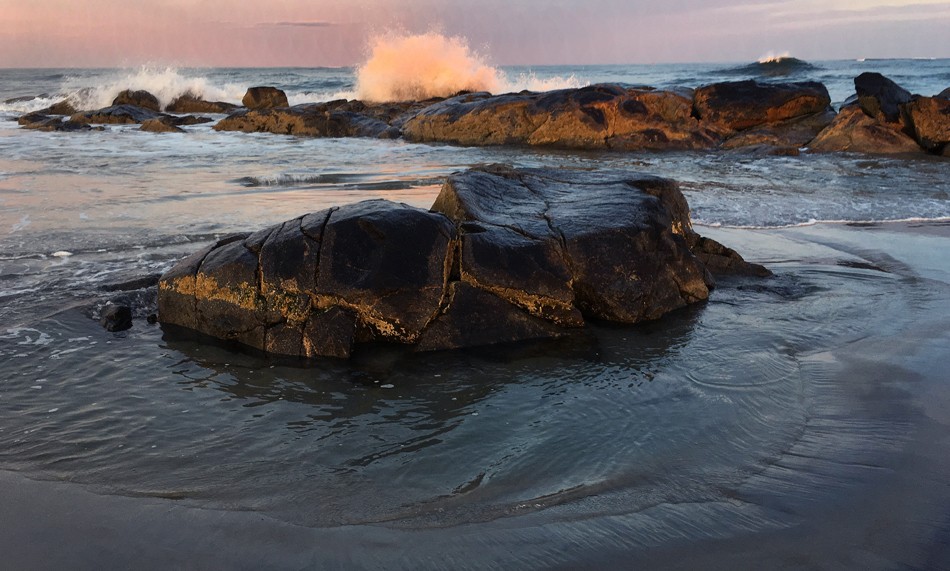 At dusk, waves crash on a rock outcropping at Hampton Beach, New Hampshire on September 30, 2018. Located twelve miles south of the present day Odiorne Point State Park along New Hampshire Route 1A, the popular summer destination spot for tourists is known for its' scenic beauty on the New Hampshire coastline, which measures in at 18.57 miles, the shortest ocean coastline of any US state. (or 235 miles of “estuarine shoreline!) Attractions and geographical proximity such as this give ample reason for visitors to visit both locales. Photo by David Spencer for PhotoSeed Archive
At dusk, waves crash on a rock outcropping at Hampton Beach, New Hampshire on September 30, 2018. Located twelve miles south of the present day Odiorne Point State Park along New Hampshire Route 1A, the popular summer destination spot for tourists is known for its' scenic beauty on the New Hampshire coastline, which measures in at 18.57 miles, the shortest ocean coastline of any US state. (or 235 miles of “estuarine shoreline!) Attractions and geographical proximity such as this give ample reason for visitors to visit both locales. Photo by David Spencer for PhotoSeed Archive
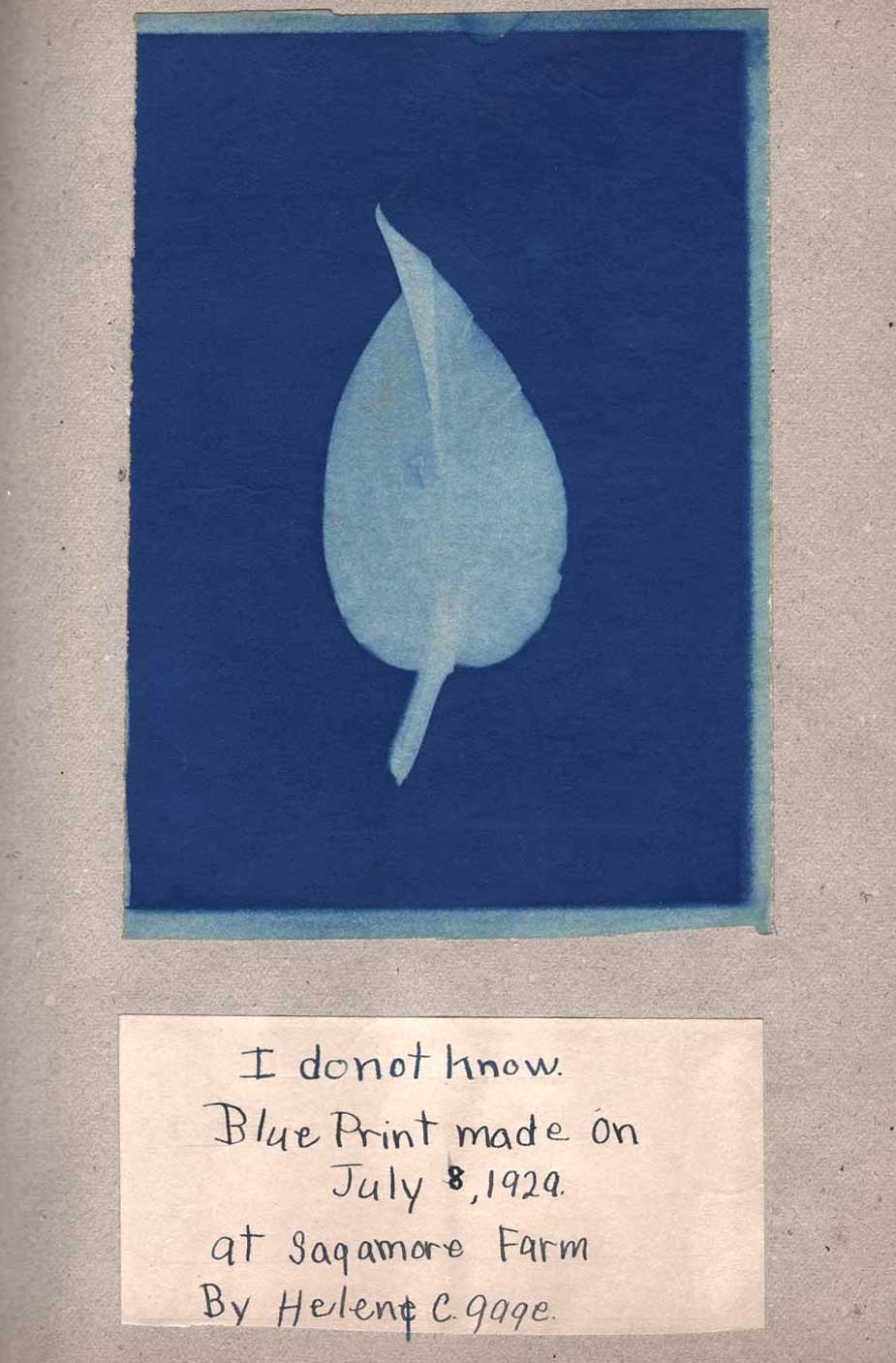 "I Do Not Know" Helen Chase Gage- American: 1917-1982; Cyanotype: 1929: (18.0 x 12.5 cm | 30.0 x 22.8 cm) Inscribed on same album page: I do not know.: Blue Print made July 8, 1929 At Sagamore Farm By Helen C. Gage. Perhaps one of the most interesting cyanotypes in both albums is this unidentified leaf specimen-endearing because the young artist who collected it was just being honest with her knowledge and told us so. As I've mentioned previously with these overall works, a few of the specimens may not be “right” botanically and possibly misidentified in some cases. Your expertise is welcomed! From: PhotoSeed Archive
"I Do Not Know" Helen Chase Gage- American: 1917-1982; Cyanotype: 1929: (18.0 x 12.5 cm | 30.0 x 22.8 cm) Inscribed on same album page: I do not know.: Blue Print made July 8, 1929 At Sagamore Farm By Helen C. Gage. Perhaps one of the most interesting cyanotypes in both albums is this unidentified leaf specimen-endearing because the young artist who collected it was just being honest with her knowledge and told us so. As I've mentioned previously with these overall works, a few of the specimens may not be “right” botanically and possibly misidentified in some cases. Your expertise is welcomed! From: PhotoSeed Archive
Feeling like a kid myself, I used my phone to show Jim one of the many fine botanical specimens Helen had made into a cyanotype from the 1930 album and realized she could have been rightly called one of the first BioBlitz scavenger hunters. As I left and walked outside the Seacoast Center, I found confirmation for Helen’s love of place on the New Hampshire seaboard all those years ago: a large group of school children getting ready to set out on their own happy discoveries.
David Spencer- October, 2018
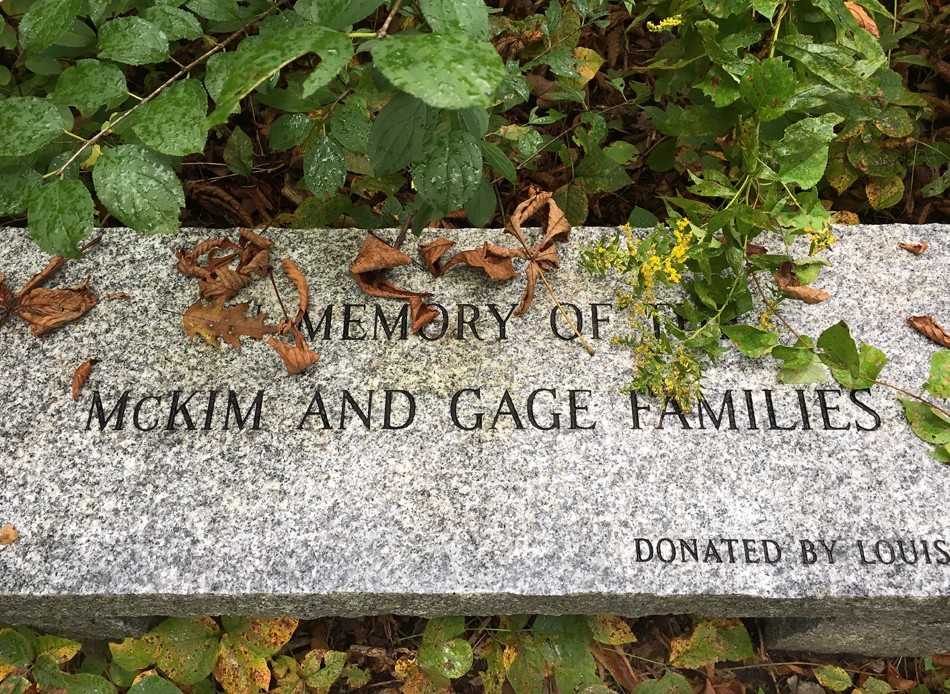 A Special Place Indeed: a poignant reminder of the property where Helen Chase Gage collected her plant specimens in order to make precious blue prints so many summers ago yields some new opportunities in the form of fall leaves and Goldenrod resting on this granite bench dedicated to the memory of the McKim and Gage families inside Rye's Odiorne Point State Park where "Sagamore Farm" once stood. Photographed October 1, 2018 by David Spencer for PhotoSeed Archive
A Special Place Indeed: a poignant reminder of the property where Helen Chase Gage collected her plant specimens in order to make precious blue prints so many summers ago yields some new opportunities in the form of fall leaves and Goldenrod resting on this granite bench dedicated to the memory of the McKim and Gage families inside Rye's Odiorne Point State Park where "Sagamore Farm" once stood. Photographed October 1, 2018 by David Spencer for PhotoSeed Archive
Afterword
An interesting segment from New Hampshire Public Radio from 2016 reports on how Odiorne Point State Park in New Hampshire was developed in the aftermath of World War II. The voice of Helen’s younger brother Edward Gage, (1919-2007) who went on to become a lawyer and spent decades trying to reclaim his family’s property is included in the report. To the credit of the park in not glossing over the loss to the Gage family and others-specifically the namesake Odiorne family who had owned property here since the 1660’s, signage outlining this history can be seen inside the Seacoast Science Center:
“In 1942,when the U.S. government took over Odiorne Point, homeowners were given short notice to vacate their beloved vacation homes and, in the case of the Odiornes, a farm that had been in their family almost three hundred years.
After the war, a debated legislative technicality at the federal level prevented Odiorne Point landowners from regaining their property. In ensuing years, discussion over what would become of the land covered the full range of development and preservation schemes.
In the end, thanks to preservation activist Annette Cottrell and the interest of New Hampshire Park Director Russell B. Tobey, the state-owned land became a park. The park is now the site of the Seacoast Science Center.
The story of Odiorne Point continues. Visitors and students from around the world are making new use of the park through the Seacoast Science Center and its educational programs. This little point of land seems destined to make more history.”
Additional Reading
-Footprints in Time: A Walk where New Hampshire Began. Compiled by Howard S. Crosby, Wendy W. Lull, and Richard T. MacIntyre: Arcardia Publishing, 1994
-Writer Anna Soper contributes additional scholarship on these albums in her article These Stunning Botanical Images Are Blueprints of the Past found on the Atlas Obscura website published October 8, 2019.
Summer Sailing
Posted June 2018 in Alternate Processes, Color Photography, Documentary Photography
Sail into Summer…
 Detail: "Summer Sailing": attributed to Arthur Hammond, American: born England:1880-1962: hand-colored gelatin silver print mounted to album leaf, ca. 1930-1940: 24.1 x 10.1 | 25.0 x 32.7 cm. From a personal album of nearly 100 photographs attributed to Hammond dating from around 1910-1940. Born in London, photographer Arthur Hammond arrived in America at Ellis Island in New York Harbor on July 31, 1909 and established himself with his own studio in Natick, MA outside Boston by 1912. In 1920, he authored the foundational book "Pictorial Composition in Photography" and became a leading voice for pictorialism in America through his position as associate editor of American Photography magazine that lasted 30 years from 1918-1949. This photo possibly taken along Boston's North Shore, with other maritime album images identified as the old Deer Island lighthouse in Boston Harbor and the original building for the Jubilee Yacht Club in Beverly Mass. From: PhotoSeed Archive
Detail: "Summer Sailing": attributed to Arthur Hammond, American: born England:1880-1962: hand-colored gelatin silver print mounted to album leaf, ca. 1930-1940: 24.1 x 10.1 | 25.0 x 32.7 cm. From a personal album of nearly 100 photographs attributed to Hammond dating from around 1910-1940. Born in London, photographer Arthur Hammond arrived in America at Ellis Island in New York Harbor on July 31, 1909 and established himself with his own studio in Natick, MA outside Boston by 1912. In 1920, he authored the foundational book "Pictorial Composition in Photography" and became a leading voice for pictorialism in America through his position as associate editor of American Photography magazine that lasted 30 years from 1918-1949. This photo possibly taken along Boston's North Shore, with other maritime album images identified as the old Deer Island lighthouse in Boston Harbor and the original building for the Jubilee Yacht Club in Beverly Mass. From: PhotoSeed ArchiveLaurels for Ivy
Posted May 2018 in Alternate Processes, Cameras, Documentary Photography, Unknown Photographers
Ivy, at least the evergreen variety known to climb and adhere to brick walls, is academically synonymous mostly in the northeastern United States with that of the Ivy League. But this isn’t about those educational institutions and membership in the well-known sports league. Rather, ivy for the purposes of this post during late Spring is symbolic for the ties that will bind newly minted graduates at this time of year: “The connection between the college and its graduates”, is how Smith College in Northampton, Massachusetts aptly describes it, and the continuing reason her senior offspring have, since 1884, ceremonially planted it on a special day before Commencement.
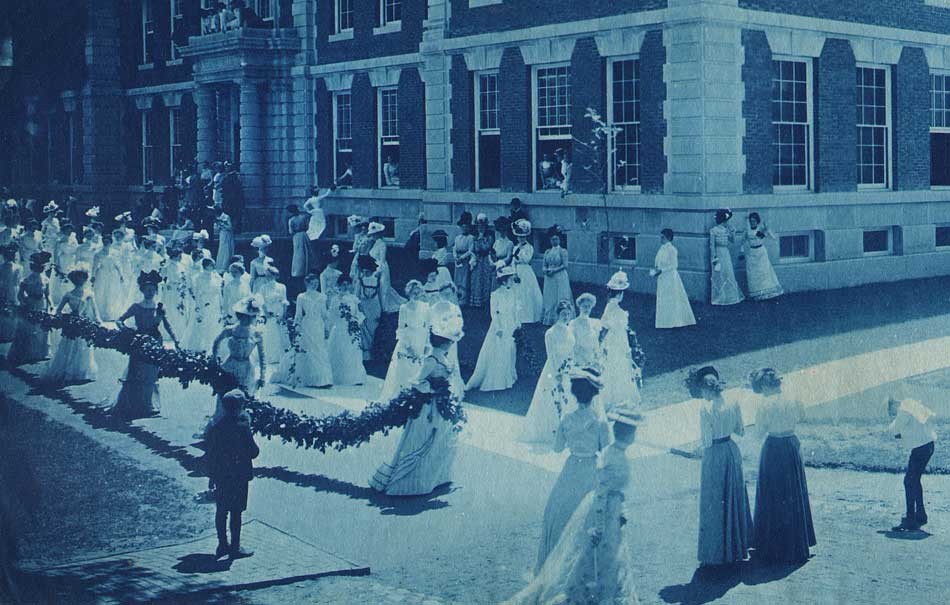 Detail: "Ivy Procession June 18, 1900": vintage cyanotype loosely inserted into dis-bound album leaf: ca. 1900 by unknown American photographer: 10.0 x 24.8 cm | 18.2 x 27.5 cm. Ivy Day at Smith College in Northampton, Massachusetts, the day before Commencement, begins with a procession of graduating seniors walking around Seelye Hall on campus. They are flanked by junior students in foreground carrying the ivy chain, which is actually made of laurel leaves. Notice the two women and young boy at far right of frame photographing the scene with box cameras. Leaf from larger album with direct provenance to Mary Ruth Perkins, 1878-1975; Smith College class of 1900 graduate and Chairman of the class yearbook committee that year. From: PhotoSeed Archive
Detail: "Ivy Procession June 18, 1900": vintage cyanotype loosely inserted into dis-bound album leaf: ca. 1900 by unknown American photographer: 10.0 x 24.8 cm | 18.2 x 27.5 cm. Ivy Day at Smith College in Northampton, Massachusetts, the day before Commencement, begins with a procession of graduating seniors walking around Seelye Hall on campus. They are flanked by junior students in foreground carrying the ivy chain, which is actually made of laurel leaves. Notice the two women and young boy at far right of frame photographing the scene with box cameras. Leaf from larger album with direct provenance to Mary Ruth Perkins, 1878-1975; Smith College class of 1900 graduate and Chairman of the class yearbook committee that year. From: PhotoSeed Archive
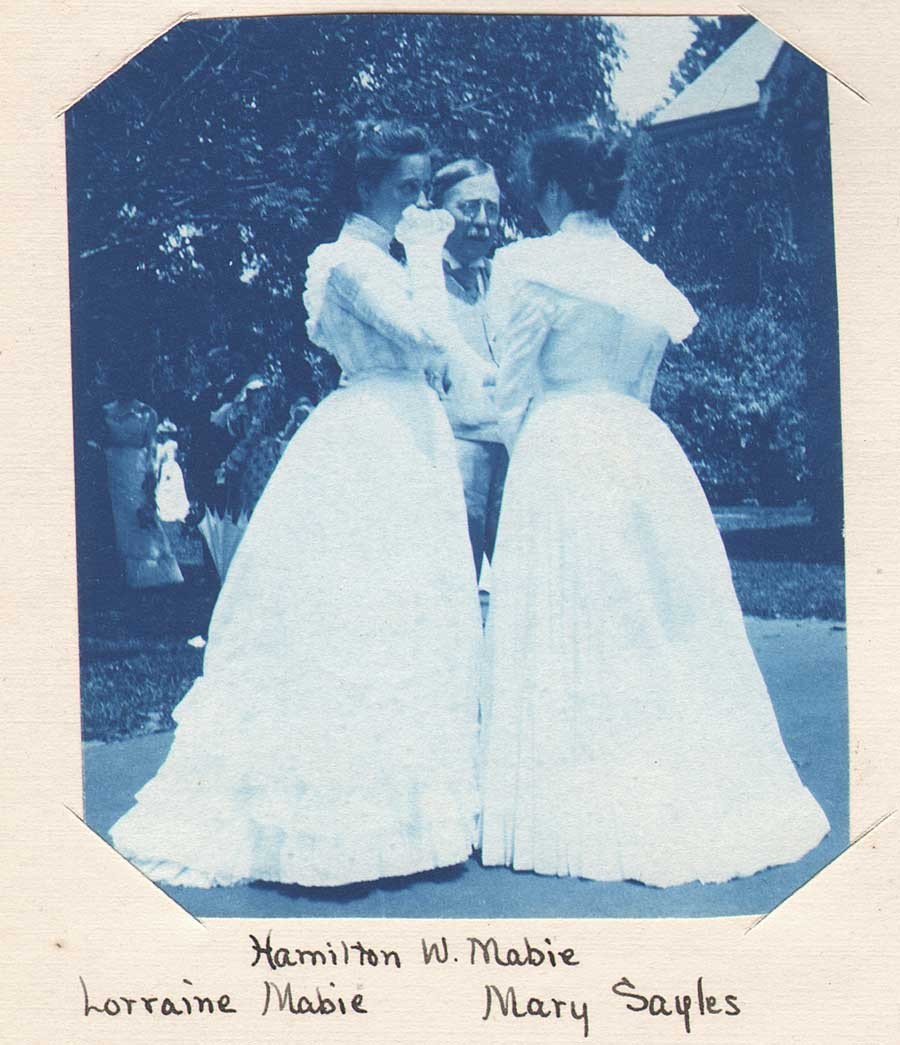 "Hamilton Wright Mabie: Smith College Class of 1900 Commencement Speaker": vintage cyanotype loosely inserted into dis-bound album leaf: ca. 1900 by unknown American photographer: 8.5 x 7.2 cm | 18.2 x 27.5 cm. Mabie, 1846-1916, an American essayist, editor, critic, and lecturer who attended Williams College and Columbia Law School, is shown here in the background along with two Smith graduates: his daughter at left Lorraine Trivett Mabie -1877-1906, and Mary Buell Sayles - 1878-1959, who went on to become a noted social reformer, writer and educator. In 1902, Sayles conducted the first "systemic study of housing conditions in Jersey City" (Davis-1984) and was a New York City housing inspector. Leaf from larger album with direct provenance to Mary Ruth Perkins, 1878-1975; Smith College class of 1900 graduate and Chairman of the class yearbook committee that year. From: PhotoSeed Archive
"Hamilton Wright Mabie: Smith College Class of 1900 Commencement Speaker": vintage cyanotype loosely inserted into dis-bound album leaf: ca. 1900 by unknown American photographer: 8.5 x 7.2 cm | 18.2 x 27.5 cm. Mabie, 1846-1916, an American essayist, editor, critic, and lecturer who attended Williams College and Columbia Law School, is shown here in the background along with two Smith graduates: his daughter at left Lorraine Trivett Mabie -1877-1906, and Mary Buell Sayles - 1878-1959, who went on to become a noted social reformer, writer and educator. In 1902, Sayles conducted the first "systemic study of housing conditions in Jersey City" (Davis-1984) and was a New York City housing inspector. Leaf from larger album with direct provenance to Mary Ruth Perkins, 1878-1975; Smith College class of 1900 graduate and Chairman of the class yearbook committee that year. From: PhotoSeed Archive
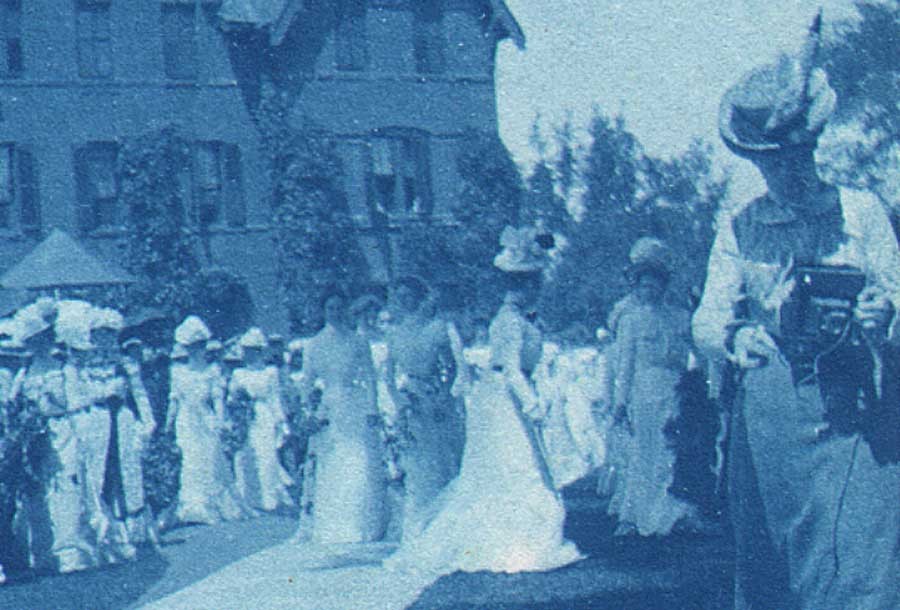 Detail: "Head of Ivy Procession" (June 18, 1900): vintage cyanotype loosely inserted into dis-bound album leaf: ca. 1900 by unknown American photographer: 7.5 x 8.5 cm | 18.2 x 27.5 cm. With the front of the Smith College Ivy Day Procession made up of graduating seniors Cornelia Gould, Carol Weston, Caroline Marmon and Harriette Ross making their way forward in background, a woman with camera at far right of frame walks to position herself for a good vantage point. Leaf from larger album with direct provenance to Mary Ruth Perkins, 1878-1975; Smith College class of 1900 graduate and Chairman of the class yearbook committee that year. From: PhotoSeed Archive
Detail: "Head of Ivy Procession" (June 18, 1900): vintage cyanotype loosely inserted into dis-bound album leaf: ca. 1900 by unknown American photographer: 7.5 x 8.5 cm | 18.2 x 27.5 cm. With the front of the Smith College Ivy Day Procession made up of graduating seniors Cornelia Gould, Carol Weston, Caroline Marmon and Harriette Ross making their way forward in background, a woman with camera at far right of frame walks to position herself for a good vantage point. Leaf from larger album with direct provenance to Mary Ruth Perkins, 1878-1975; Smith College class of 1900 graduate and Chairman of the class yearbook committee that year. From: PhotoSeed Archive
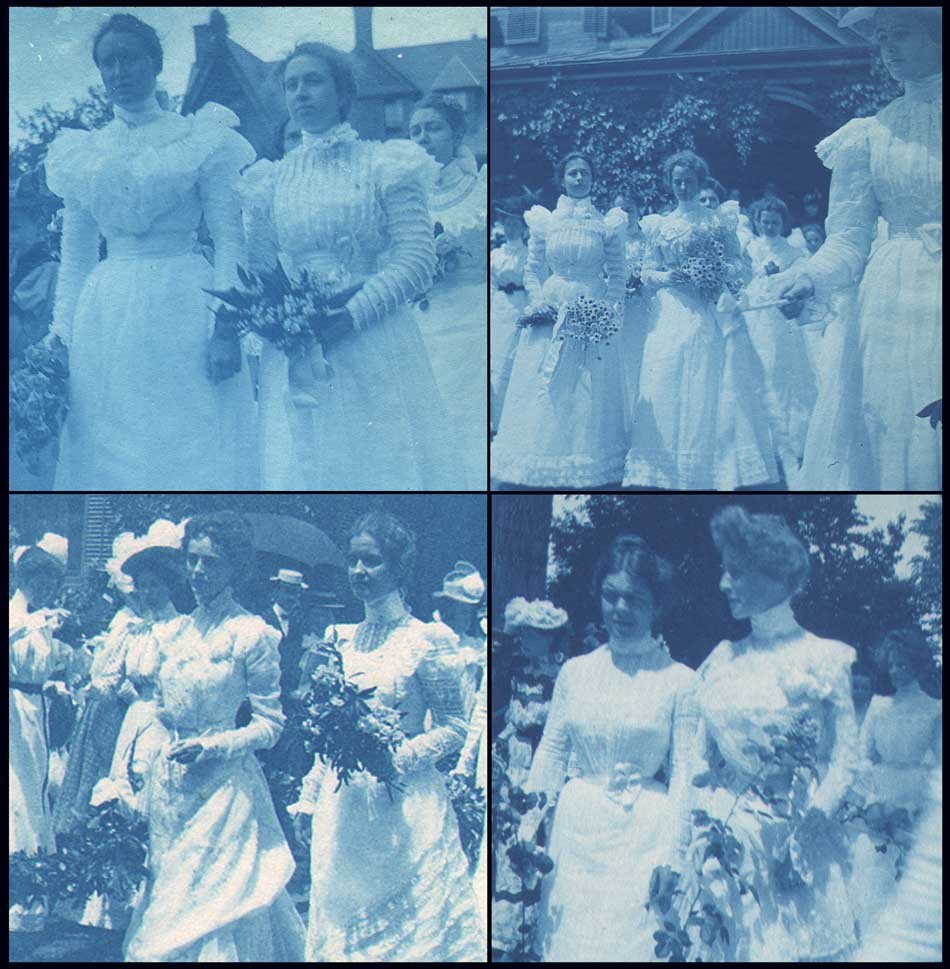 Details: "Head of Ivy Day Procession: 1897-1900" (Smith College, Northampton, Massachusetts). All: vintage cyanotypes loosely inserted into dis-bound album leaves: ca. 1897-1900 by unknown American photographers with each leaf: 18.2 x 27.5 cm. Upper left: 1897: 9.4 x 11.4 cm; Upper right: 1898: 9.5 x 12.0 cm; Lower left: 1899 (Louise & Carrolle Barber) 8.5 x 5.5 cm; Lower right: 1900 (Cornelia Gould, Carol Weston, Caroline Marmon, Harriette Ross) 8.1 x 5.5 cm. Leaves from larger album with direct provenance to Mary Ruth Perkins, 1878-1975; Smith College class of 1900 graduate and Chairman of the class yearbook committee that year. From: PhotoSeed Archive
Details: "Head of Ivy Day Procession: 1897-1900" (Smith College, Northampton, Massachusetts). All: vintage cyanotypes loosely inserted into dis-bound album leaves: ca. 1897-1900 by unknown American photographers with each leaf: 18.2 x 27.5 cm. Upper left: 1897: 9.4 x 11.4 cm; Upper right: 1898: 9.5 x 12.0 cm; Lower left: 1899 (Louise & Carrolle Barber) 8.5 x 5.5 cm; Lower right: 1900 (Cornelia Gould, Carol Weston, Caroline Marmon, Harriette Ross) 8.1 x 5.5 cm. Leaves from larger album with direct provenance to Mary Ruth Perkins, 1878-1975; Smith College class of 1900 graduate and Chairman of the class yearbook committee that year. From: PhotoSeed Archive
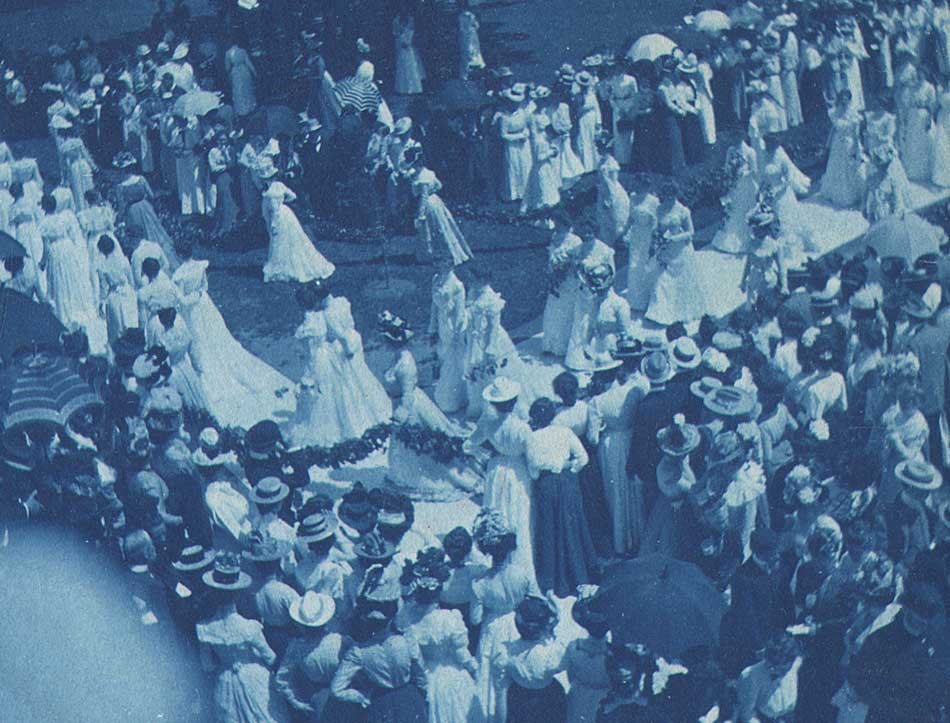 Detail: "Ivy Procession on the way from College Hall around Seelye Hall" (June 18, 1900): vintage cyanotype loosely inserted into dis-bound album leaf: ca. 1900 by unknown American photographer: 8.3 x 8.5 cm | 18.2 x 27.5 cm.Taken from an overhead angle, this photograph shows throngs of hat wearing spectators in foreground and background watching the procession of graduating Smith College seniors. Each wearing their traditional long white dresses, they walk in pairs while flanked by junior class members holding the ivy chain made from laurel leaves. Leaf from larger album with direct provenance to Mary Ruth Perkins, 1878-1975; Smith College class of 1900 graduate and Chairman of the class yearbook committee that year. From: PhotoSeed Archive
Detail: "Ivy Procession on the way from College Hall around Seelye Hall" (June 18, 1900): vintage cyanotype loosely inserted into dis-bound album leaf: ca. 1900 by unknown American photographer: 8.3 x 8.5 cm | 18.2 x 27.5 cm.Taken from an overhead angle, this photograph shows throngs of hat wearing spectators in foreground and background watching the procession of graduating Smith College seniors. Each wearing their traditional long white dresses, they walk in pairs while flanked by junior class members holding the ivy chain made from laurel leaves. Leaf from larger album with direct provenance to Mary Ruth Perkins, 1878-1975; Smith College class of 1900 graduate and Chairman of the class yearbook committee that year. From: PhotoSeed Archive
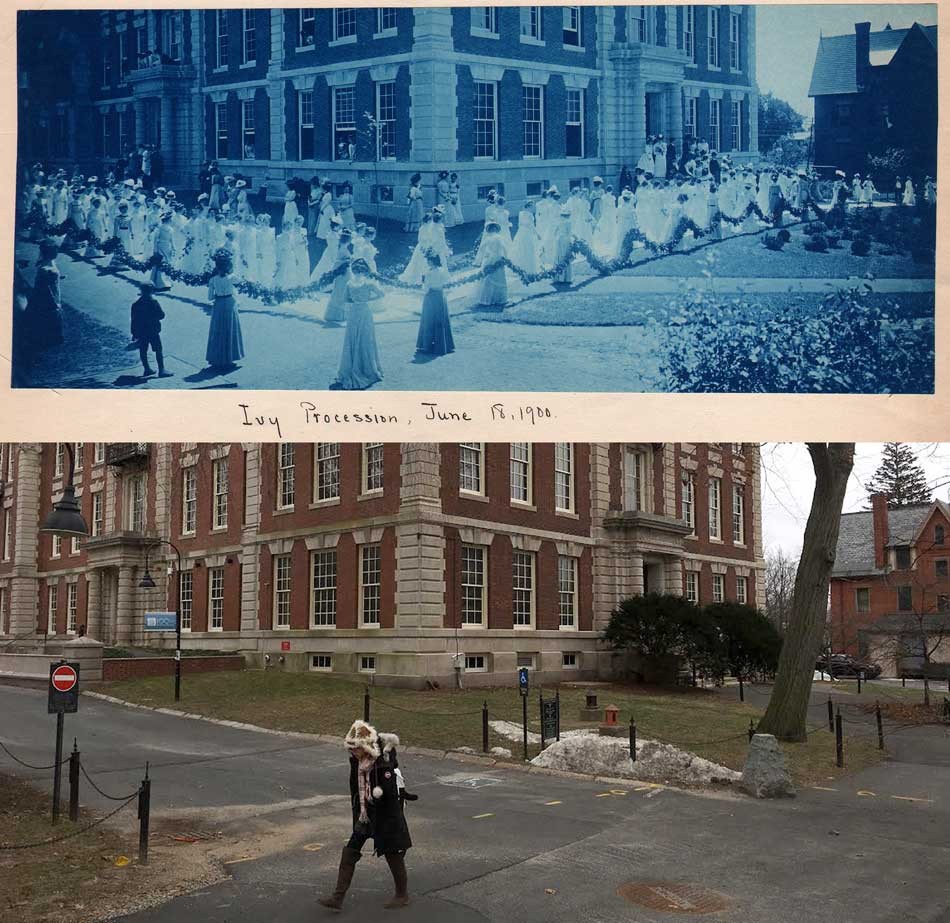 Top: "Ivy Procession June 18, 1900": vintage cyanotype loosely inserted into dis-bound album leaf: ca. 1900 by unknown American photographer: 10.1 x 24.5 cm | 18.2 x 27.5 cm. Ivy Day at Smith College in Northampton, Massachusetts, the day before Commencement, begins with a procession of graduating seniors walking around Seelye Hall on campus. They are flanked by junior students in foreground carrying the ivy chain, which is actually made of laurel leaves. From the college website: "Ivy Day has been a Smith tradition for more than a century. The class of 1884 was the first to plant ivy as part of the ceremonies leading to its graduation, thus providing the day with its name." Leaf from larger album with direct provenance to Mary Ruth Perkins, 1878-1975; Smith College class of 1900 graduate and Chairman of the class yearbook committee that year. From: PhotoSeed Archive. Bottom: "Seelye Hall, Smith College Campus". From the same vantage point as the panoramic photograph taken above, this digital iPhone photograph from January 15, 2018 shows what the campus looks like today. Named after the first president of the college L. Clark Seelye, construction on Seelye began in 1898 and it opened the following year. Photo by David Spencer for PhotoSeed Archive.
Top: "Ivy Procession June 18, 1900": vintage cyanotype loosely inserted into dis-bound album leaf: ca. 1900 by unknown American photographer: 10.1 x 24.5 cm | 18.2 x 27.5 cm. Ivy Day at Smith College in Northampton, Massachusetts, the day before Commencement, begins with a procession of graduating seniors walking around Seelye Hall on campus. They are flanked by junior students in foreground carrying the ivy chain, which is actually made of laurel leaves. From the college website: "Ivy Day has been a Smith tradition for more than a century. The class of 1884 was the first to plant ivy as part of the ceremonies leading to its graduation, thus providing the day with its name." Leaf from larger album with direct provenance to Mary Ruth Perkins, 1878-1975; Smith College class of 1900 graduate and Chairman of the class yearbook committee that year. From: PhotoSeed Archive. Bottom: "Seelye Hall, Smith College Campus". From the same vantage point as the panoramic photograph taken above, this digital iPhone photograph from January 15, 2018 shows what the campus looks like today. Named after the first president of the college L. Clark Seelye, construction on Seelye began in 1898 and it opened the following year. Photo by David Spencer for PhotoSeed Archive.
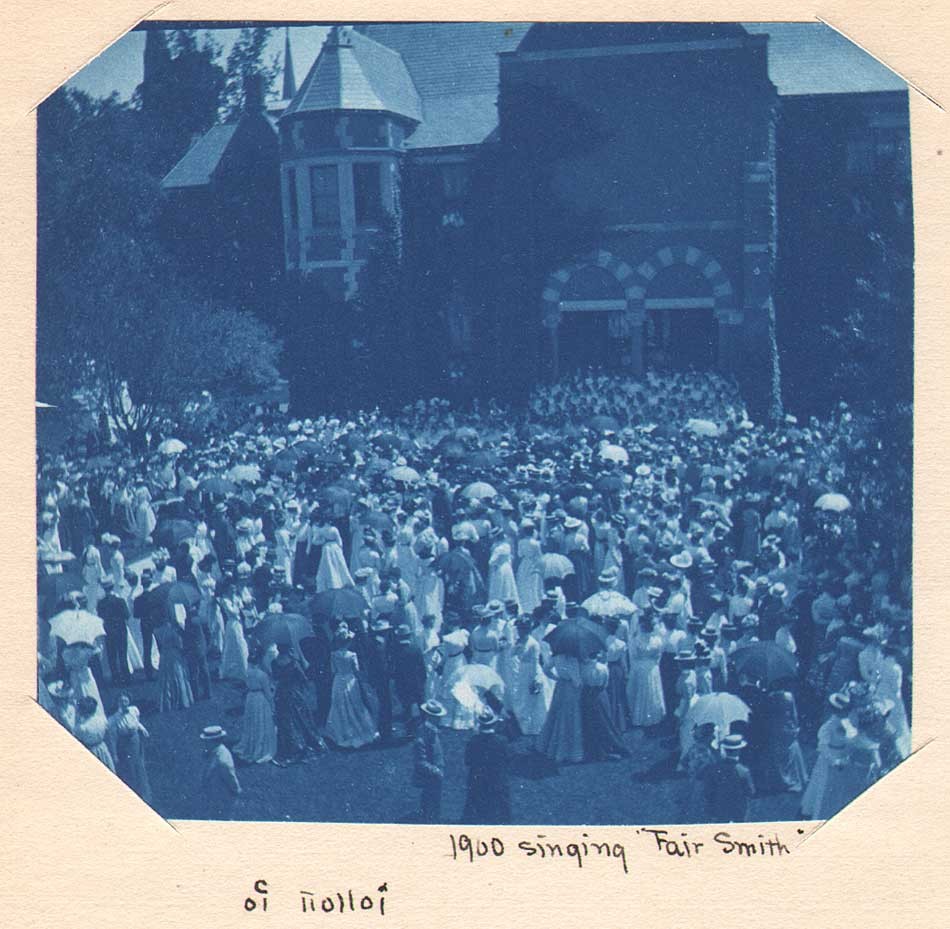 "Singing Fair Smith": vintage cyanotype loosely inserted into dis-bound album leaf: ca. 1900 by unknown American photographer: 7.7 x 8.5 cm | 18.2 x 27.5 cm. On Ivy Day at Smith College in Northampton, Massachusetts, hundreds gather in front of College Hall to watch members of the choir assembled on the steps sing the traditional 1890 song "Fair Smith". The lyrics are by R.K. Crandall and Dr. B.C. Blodgett: "Fair Smith, our praise to thee we render, O dearest college halls, Bright hours that live in mem'ry tender, Are wing'd within thy walls. O'er thy walks the elms are bowing, Alma Mater, Winds 'mid branches softly blowing, Ivy round thy tower growing, Alma Mater. "And while the hills with purple shadows Eternal vigil keep Above the happy river meadows, In golden haze asleep. May thy children still addressing, Alma Mater. Thee with grateful praise addressing, Speak in loyal hearts thy blessing, Alma Mater." Leaf from larger album with direct provenance to Mary Ruth Perkins, 1878-1975; Smith College class of 1900 graduate and Chairman of the class yearbook committee that year. From: PhotoSeed Archive
"Singing Fair Smith": vintage cyanotype loosely inserted into dis-bound album leaf: ca. 1900 by unknown American photographer: 7.7 x 8.5 cm | 18.2 x 27.5 cm. On Ivy Day at Smith College in Northampton, Massachusetts, hundreds gather in front of College Hall to watch members of the choir assembled on the steps sing the traditional 1890 song "Fair Smith". The lyrics are by R.K. Crandall and Dr. B.C. Blodgett: "Fair Smith, our praise to thee we render, O dearest college halls, Bright hours that live in mem'ry tender, Are wing'd within thy walls. O'er thy walks the elms are bowing, Alma Mater, Winds 'mid branches softly blowing, Ivy round thy tower growing, Alma Mater. "And while the hills with purple shadows Eternal vigil keep Above the happy river meadows, In golden haze asleep. May thy children still addressing, Alma Mater. Thee with grateful praise addressing, Speak in loyal hearts thy blessing, Alma Mater." Leaf from larger album with direct provenance to Mary Ruth Perkins, 1878-1975; Smith College class of 1900 graduate and Chairman of the class yearbook committee that year. From: PhotoSeed Archive
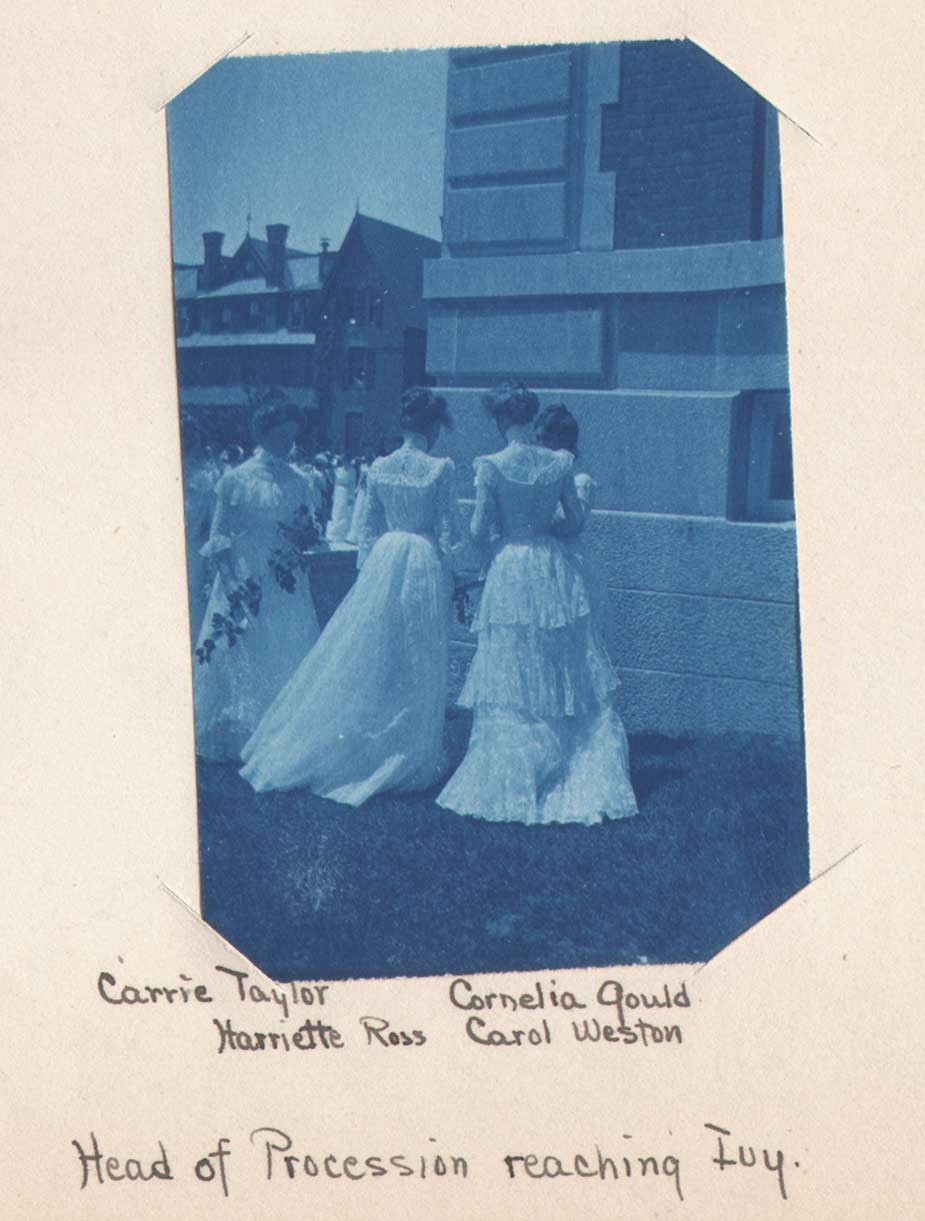 "Head of Procession reaching Ivy": vintage cyanotype loosely inserted into dis-bound album leaf: ca. 1900 by unknown American photographer: 8.3 x 5.4 cm | 18.2 x 27.5 cm. Smith College graduating seniors who headed up the Ivy Day Procession on June 18, 1900-Cornelia Gould, Carol Weston, Caroline Marmon and Harriette Ross, stand at the base of Seelye Hall where they prepare to plant ivy plant seedlings. Leaf from larger album with direct provenance to Mary Ruth Perkins, 1878-1975; Smith College class of 1900 graduate and Chairman of the class yearbook committee that year. From: PhotoSeed Archive
"Head of Procession reaching Ivy": vintage cyanotype loosely inserted into dis-bound album leaf: ca. 1900 by unknown American photographer: 8.3 x 5.4 cm | 18.2 x 27.5 cm. Smith College graduating seniors who headed up the Ivy Day Procession on June 18, 1900-Cornelia Gould, Carol Weston, Caroline Marmon and Harriette Ross, stand at the base of Seelye Hall where they prepare to plant ivy plant seedlings. Leaf from larger album with direct provenance to Mary Ruth Perkins, 1878-1975; Smith College class of 1900 graduate and Chairman of the class yearbook committee that year. From: PhotoSeed Archive
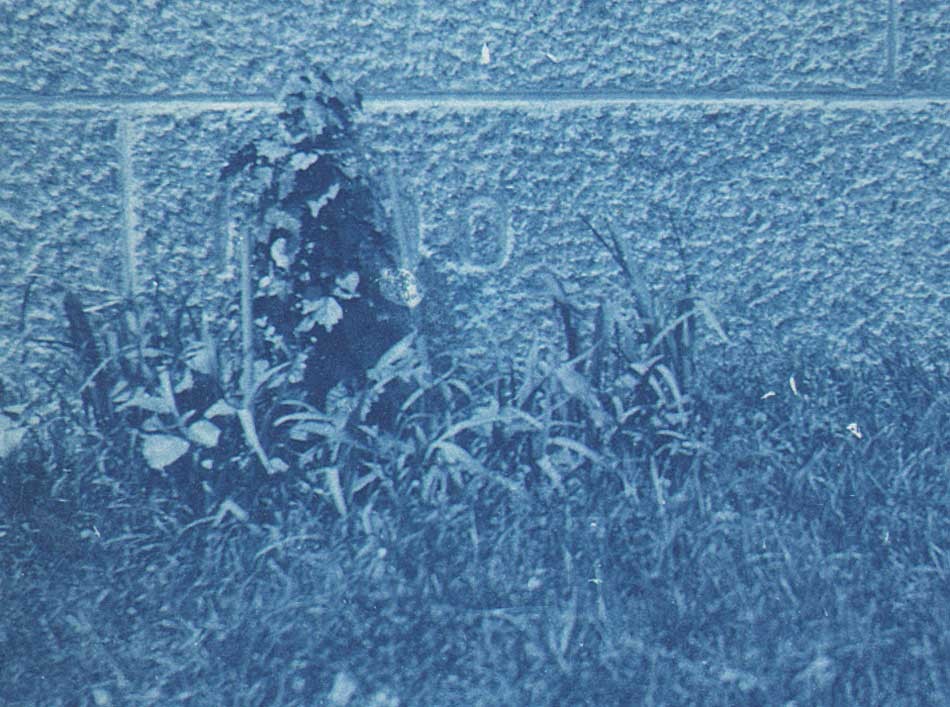 Detail: "Ivy vine seedling at base of Seelye Hall": vintage cyanotype loosely inserted into dis-bound album leaf: ca. 1900 by unknown American photographer: 8.3 x 8.0 cm | 18.2 x 27.5 cm. The evidence of Ivy Day at Smith College on June 18, 1900 is this Ivy seedling, planted against the year "1900" chiseled into the base of the then brand new Seelye Hall, a rusticated Georgian Revival building on campus designed by the New York firm of York and Sawyer. Construction on this surviving academic building which first housed classrooms and a library began in 1898 and was completed in 1899. The building took its name from L. Clark Seelye, (1837-1924) the first president of Smith College who served from 1875-1910. Rockefeller Hall at Vassar, an 1897 commission by the same firm, was the model for Seelye. Leaf from larger album with direct provenance to Mary Ruth Perkins, 1878-1975; Smith College class of 1900 graduate and Chairman of the class yearbook committee that year. From: PhotoSeed Archive
Detail: "Ivy vine seedling at base of Seelye Hall": vintage cyanotype loosely inserted into dis-bound album leaf: ca. 1900 by unknown American photographer: 8.3 x 8.0 cm | 18.2 x 27.5 cm. The evidence of Ivy Day at Smith College on June 18, 1900 is this Ivy seedling, planted against the year "1900" chiseled into the base of the then brand new Seelye Hall, a rusticated Georgian Revival building on campus designed by the New York firm of York and Sawyer. Construction on this surviving academic building which first housed classrooms and a library began in 1898 and was completed in 1899. The building took its name from L. Clark Seelye, (1837-1924) the first president of Smith College who served from 1875-1910. Rockefeller Hall at Vassar, an 1897 commission by the same firm, was the model for Seelye. Leaf from larger album with direct provenance to Mary Ruth Perkins, 1878-1975; Smith College class of 1900 graduate and Chairman of the class yearbook committee that year. From: PhotoSeed Archive
In 1900, when these cyanotype photographs were taken, a new century beckoned on Ivy Day for those who would soon graduate from Smith. Like then as in the present, newly minted graduates the world over feel the same emotions that strains of Pomp and Circumstance invoke and traditions call for. Laurels are bestowed for hard work, fortunes and insight will be made or come from it, and hopefully, friendships made during college days will endure far into the future.
Camera Work: Back in Print
Posted May 2018 in Advertising, History of Photography, Journals, Significant Photographers
Like the mythological bird the Phoenix, the groundbreaking photography and art journal Camera Work edited and published by Alfred Stieglitz of New York from 1903-17 is now available for purchase as a full run after long being out of print.
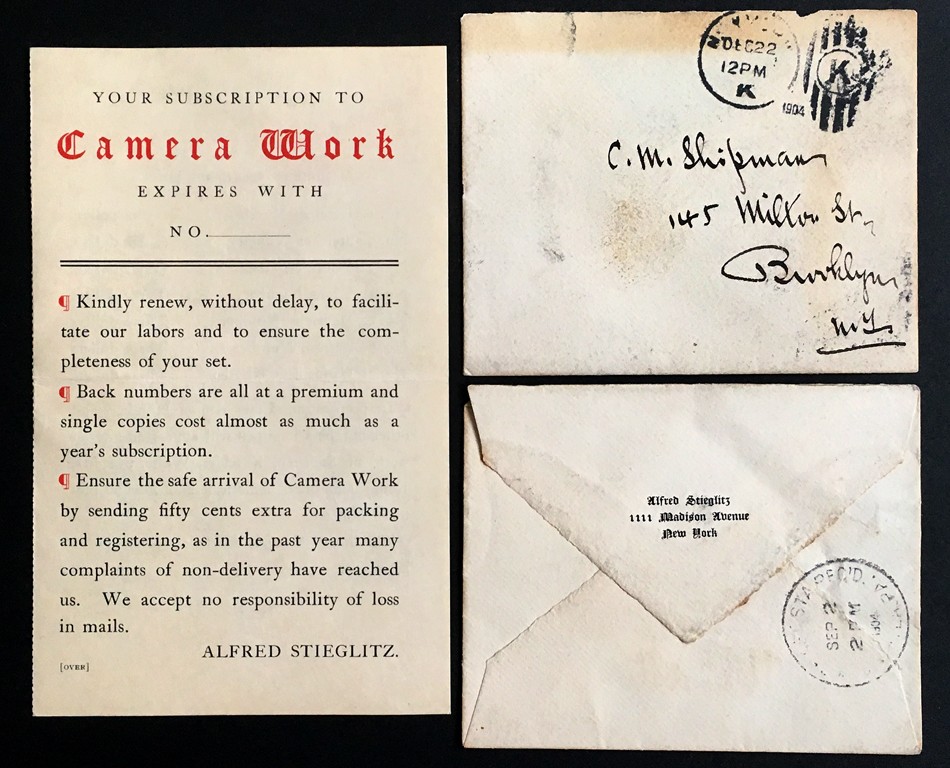 Rare Camera Work Ephemera: Left: This blank Camera Work subscription form for the year 1905 was mailed by publisher Alfred Stieglitz to photographer C.M. Shipman in Brooklyn, New York. (145 Milton St.) recto: 15.9 x 9.9 cm | opened: 9.9 x 19.8 cm | printed on Japan paper. Upper Right: The original mailing envelope (8.7 x 10.8 cm) addressed to Shipman in Stieglitz’s hand is stamped with a New York postmark of December 22, 1904. Lower Right: Another similar envelope addressed to photographer Adolph Petzold in Philadelphia and postmarked New York, September, 1904 is engraved on the verso: Alfred Stieglitz- 1111 Madison Avenue - New York. From: PhotoSeed Archive
Rare Camera Work Ephemera: Left: This blank Camera Work subscription form for the year 1905 was mailed by publisher Alfred Stieglitz to photographer C.M. Shipman in Brooklyn, New York. (145 Milton St.) recto: 15.9 x 9.9 cm | opened: 9.9 x 19.8 cm | printed on Japan paper. Upper Right: The original mailing envelope (8.7 x 10.8 cm) addressed to Shipman in Stieglitz’s hand is stamped with a New York postmark of December 22, 1904. Lower Right: Another similar envelope addressed to photographer Adolph Petzold in Philadelphia and postmarked New York, September, 1904 is engraved on the verso: Alfred Stieglitz- 1111 Madison Avenue - New York. From: PhotoSeed Archive
Remarkably and metaphorically, this bird, capably guided by St. Louis resident Pierre Vreyen, has risen again even though its first creator, while acknowledging the passion it took to create it was a most admirable thing, nonetheless went on to dispose of at least one known full run of Camera Work by setting it alight in 1929 at his Lake George estate. In 1933, writing in a two-page letter on July 10 from there to writer and critic Lewis Mumford, Stieglitz outlines the emotional capital he expended on his involvement with and creation of Camera Work:
“Four years ago the complete set of Camera Work I had had up here for years I offered to the Evening Star. It was a wonderful sight to watch the volumes burn. As you know books burn slowly…What a continuous heartache Camera Work represented & what blood was spilled over each issue fighting printers & fighting engravers—fighting paper dealers & paper manufacturers—fighting ink manufacturers & binders—fighting those who did the packing—fighting the post office—every step I controlled personally—as I sat there & realized what passion it all represented—I had to smile at myself.—Ye gods what won’t passion do.” (1.)
Originally from Liege, Belgium and trained as an electrician and draftsman but more recently plying his trade as a commercial photographer, Pierre explained to me his inspiration for bringing Camera Work back to life, so to speak:
“It all started when Mark (Katzman) said he would love to have a digital copy of Camera Work so he could open it anytime without the fear of over-manipulating his set of originals. I told him I would give him a hand doing it and it took 2 years to make.”
With the establishment of his website cameraworkmagazine.com, which includes short videos of him leafing through each newly published issue of Camera Work, one can order the full run of the journal in facsimile: the most complete and faithful copy of the original ever published. The cost is $1200, which includes a separate index issue, plus shipping.
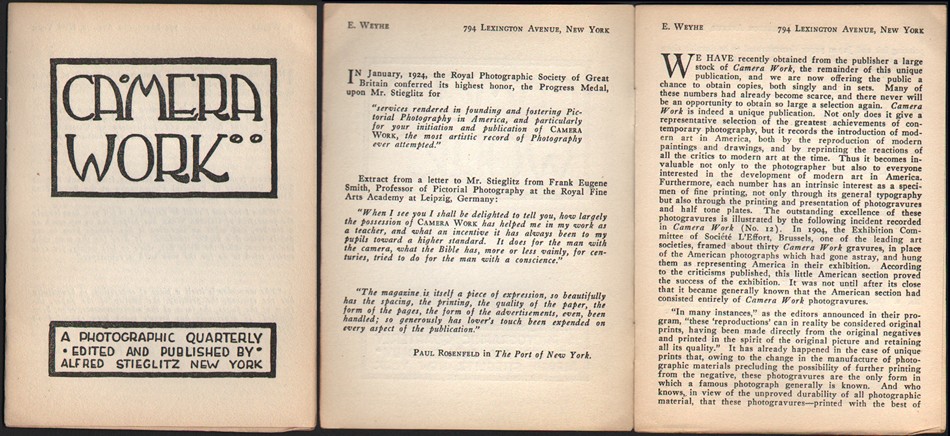 “Earliest known Camera Work Sales Catalogue” ( post publication): ca. 1924, uncoated paper: 13.8 x 10.1 cm (Cover). New York: E. Weyhe Gallery. This small pamphlet shows a facsimile of the CW cover at left while opened to the first gatefold at right. The prospectus by the E. Weyhe Gallery, located at 794 Lexington Avenue in New York City, reprinted press notices for CW along with a synopsis of available issues and prices, including the final Paul Strand double issue 49-50 from 1917 for $17.50: An excerpt: "We Have recently obtained from the publisher a large stock of Camera Work, the remainder of this unique chance to obtain copies, both singly and in sets. Many of these numbers had already become scarce, and there never will be an opportunity to obtain so large a selection again." From: PhotoSeed Archive
“Earliest known Camera Work Sales Catalogue” ( post publication): ca. 1924, uncoated paper: 13.8 x 10.1 cm (Cover). New York: E. Weyhe Gallery. This small pamphlet shows a facsimile of the CW cover at left while opened to the first gatefold at right. The prospectus by the E. Weyhe Gallery, located at 794 Lexington Avenue in New York City, reprinted press notices for CW along with a synopsis of available issues and prices, including the final Paul Strand double issue 49-50 from 1917 for $17.50: An excerpt: "We Have recently obtained from the publisher a large stock of Camera Work, the remainder of this unique chance to obtain copies, both singly and in sets. Many of these numbers had already become scarce, and there never will be an opportunity to obtain so large a selection again." From: PhotoSeed Archive
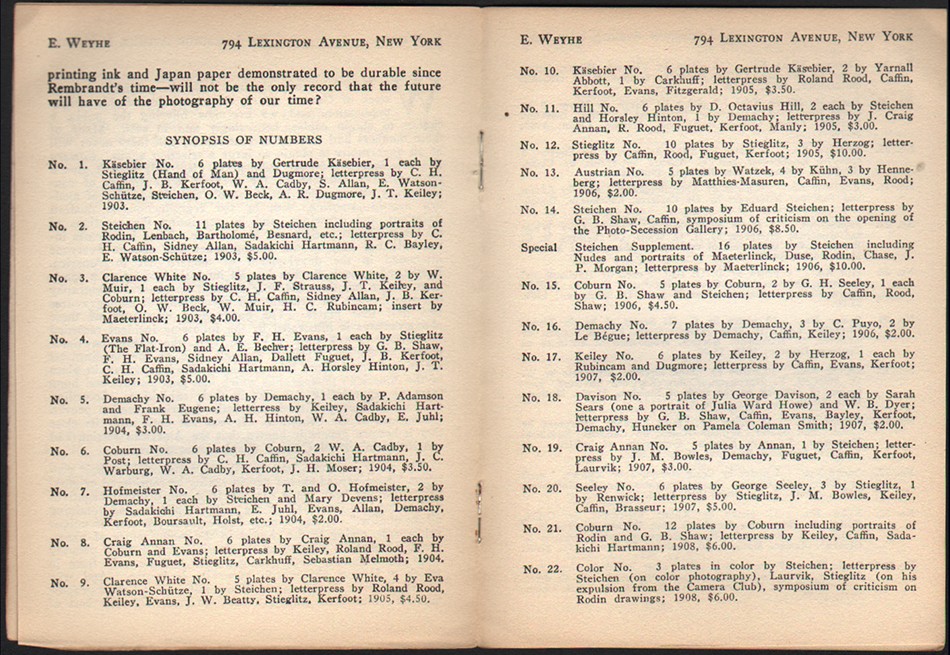 “Synopsis of Numbers: 1-22”: “Earliest known Camera Work Sales Catalogue” ( post publication): ca. 1924, uncoated paper: 13.8 x 20.1 cm (this gatefold). New York: E. Weyhe Gallery. The prospectus by the E. Weyhe Gallery, located at 794 Lexington Avenue in New York City, reprinted press notices for CW along with a synopsis of available issues and prices, including the final Paul Strand double issue 49-50 from 1917 for $17.50: An excerpt: "We Have recently obtained from the publisher a large stock of Camera Work, the remainder of this unique chance to obtain copies, both singly and in sets. Many of these numbers had already become scarce, and there never will be an opportunity to obtain so large a selection again." From: PhotoSeed Archive
“Synopsis of Numbers: 1-22”: “Earliest known Camera Work Sales Catalogue” ( post publication): ca. 1924, uncoated paper: 13.8 x 20.1 cm (this gatefold). New York: E. Weyhe Gallery. The prospectus by the E. Weyhe Gallery, located at 794 Lexington Avenue in New York City, reprinted press notices for CW along with a synopsis of available issues and prices, including the final Paul Strand double issue 49-50 from 1917 for $17.50: An excerpt: "We Have recently obtained from the publisher a large stock of Camera Work, the remainder of this unique chance to obtain copies, both singly and in sets. Many of these numbers had already become scarce, and there never will be an opportunity to obtain so large a selection again." From: PhotoSeed Archive
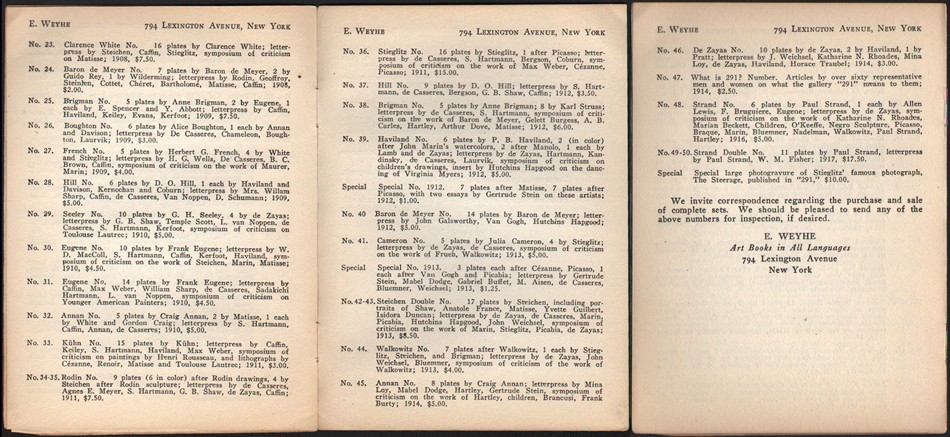 “Synopsis of Numbers: 23-48; 49-50; 2 special issues and special large plate gravure of The Steerage”: “Earliest known Camera Work Sales Catalogue” ( post publication): ca. 1924, uncoated paper: 13.8 x 20.1 cm (gatefold at left and back cover at right: 13.8 x 10.1 cm ). New York: E. Weyhe Gallery. The prospectus by the E. Weyhe Gallery, located at 794 Lexington Avenue in New York City, reprinted press notices for CW along with a synopsis of available issues and prices, including the final Paul Strand double issue 49-50 from 1917 for $17.50: An excerpt: "We Have recently obtained from the publisher a large stock of Camera Work, the remainder of this unique chance to obtain copies, both singly and in sets. Many of these numbers had already become scarce, and there never will be an opportunity to obtain so large a selection again." From: PhotoSeed Archive
“Synopsis of Numbers: 23-48; 49-50; 2 special issues and special large plate gravure of The Steerage”: “Earliest known Camera Work Sales Catalogue” ( post publication): ca. 1924, uncoated paper: 13.8 x 20.1 cm (gatefold at left and back cover at right: 13.8 x 10.1 cm ). New York: E. Weyhe Gallery. The prospectus by the E. Weyhe Gallery, located at 794 Lexington Avenue in New York City, reprinted press notices for CW along with a synopsis of available issues and prices, including the final Paul Strand double issue 49-50 from 1917 for $17.50: An excerpt: "We Have recently obtained from the publisher a large stock of Camera Work, the remainder of this unique chance to obtain copies, both singly and in sets. Many of these numbers had already become scarce, and there never will be an opportunity to obtain so large a selection again." From: PhotoSeed Archive
Pierre says: “The aim of this project is to put (Camera Work) in the hands of schools, teachers, students, museums, libraries, collectors, appraisers, auction houses, individuals, etc… a high quality reproduction of the originals at a reasonable price.”
Intrigued, I asked him what some of the challenges were for pulling the project off, and I couldn’t help but think of parallels Stieglitz himself surely encountered, yet updated for the digital age:
“There were many challenges. At first was where to start? From what? Luckily I found the Modernist Journal Project online which has a digital copy of Camera Work. It is incomplete but we contacted them and they were kind enough to supply us with their raw files. I used their files for the text pages but not for the plates.
The text pages needed a lot of work in Photoshop to clean, resize, straighten, etc… and then we had to photograph many of the plate pages Mark (Katzman) had no high res files in his archive. I also had to align the often found ghost image present on the facing page of the plates. Look at the video clips I have on the website and you’ll see what I mean. Especially visible in number 49-50.”
Continuing, and with the knowledge he has put up a significant amount of his own money to complete 25 full sets of Camera Work, Pierre spoke of finding someone to print the issues, something that happens less and less in this digital age:
…“I had to find a printer. I first looked online but the choices are limited and it ends up getting expensive really quick when you want to use a print on demand service like blurb.com. So I looked locally.
 International Camera Work Scholarship: With "The Red Man", a head study reproduced as a photogravure plate in Camera Work I by Gertrude Käsebier from 1903 projected on the screen at left, Professor Dr. Bettina Gockel, principal investigator for the project Camera Work: Inside/Out at the University of Zurich from 2015-18 delivers her paper: "More Than Genius: The Invention of Photographic Genius and the Importance of the Journal Camera Work" during the symposium Rethinking "Pictorialism": American Art and Photography, 1895 to 1925 at Princeton University in October, 2017. Photo by David Spencer for PhotoSeed Archive
International Camera Work Scholarship: With "The Red Man", a head study reproduced as a photogravure plate in Camera Work I by Gertrude Käsebier from 1903 projected on the screen at left, Professor Dr. Bettina Gockel, principal investigator for the project Camera Work: Inside/Out at the University of Zurich from 2015-18 delivers her paper: "More Than Genius: The Invention of Photographic Genius and the Importance of the Journal Camera Work" during the symposium Rethinking "Pictorialism": American Art and Photography, 1895 to 1925 at Princeton University in October, 2017. Photo by David Spencer for PhotoSeed Archive
I found a printer that was in St. Louis but after many, many weeks of proofs and tries, it did not work out. Back to square 1, I found another printer about 80 miles from St. Louis and this is the one I ended up using. All in all, it took me 6 months dealing with different printers to finally get what you saw in Rochester, the final product.”
As an added bonus, Pierre will also sell you a piece of history from the pages of Camera Work: approximately 180 individual advertising pages from the journal are listed on his site and can be ordered as 16 x 20” framable art prints for the bargain of $30 each.
Would the master Approve?
Not that my opinion matters, but here goes. It’s hard to guess if Alfred Stieglitz would have embraced the concept of digitization. My hunch says no, because I want to believe one of the most important legacies he left the world, Camera Work magazine, was something he would have been insistent be appreciated in its’ original form.
All well and good if you can get ahold of vintage copies, or have the tenacity and financial resources to acquire a full run of the 50 issues and supplements. But to those of us in the 21st century, the importance of the groundbreaking nature of the journal as well as the superb photogravure plates contained within give many of us ample reason to collect at least a few of the plates.
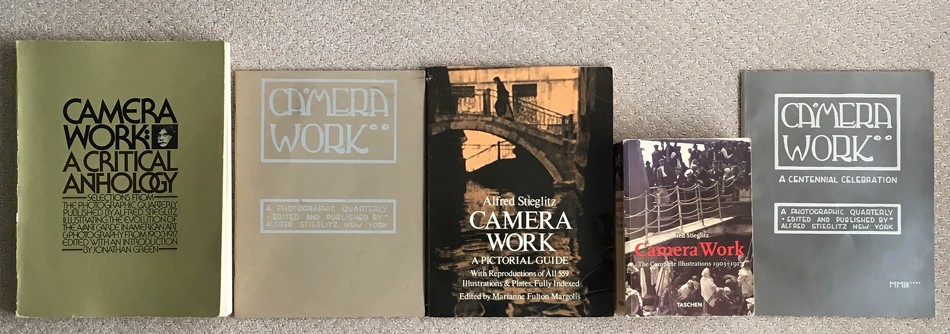 Published Literature: Camera Work: A chronological timeline of significant works are seen left to right: 1973: "Camera Work: A Critical Anthology" by Jonathan Green. This was the first significant evaluation of Camera Work, with an emphasis on the articles and text rather than the reproductions; 1973: "Camera Work: A Photographic Quarterly Edited and Published by Alfred Stieglitz, New York". Published by the Minneapolis Institute of Arts, this volume accompanied the exhibition, “I Am an American,” that traveled to more than a dozen towns in Minnesota on the Minneapolis Institute of Arts’ Artmobile; 1978: "Camera Work: A Pictorial Guide" by Marianne Fulton Margolis was the first instance all 559 plates from Camera Work were published in a single-volume reference; 1997: "Camera Work- The Complete Illustrations 1903-1917". Published by Benedikt Taschen with an essay by Pam Roberts additionally translated into German and French, it featured all plates taken from a complete set of the journal owned by the Royal Photographic Society, Bath; 2003: "Camera Work: A Centennial Celebration": In celebration of the 100th anniversary of the publication of Camera Work, a traveling exhibition was organized by Stephen Perloff, editor of The Photo Review and The Photograph Collector. From: PhotoSeed Archive
Published Literature: Camera Work: A chronological timeline of significant works are seen left to right: 1973: "Camera Work: A Critical Anthology" by Jonathan Green. This was the first significant evaluation of Camera Work, with an emphasis on the articles and text rather than the reproductions; 1973: "Camera Work: A Photographic Quarterly Edited and Published by Alfred Stieglitz, New York". Published by the Minneapolis Institute of Arts, this volume accompanied the exhibition, “I Am an American,” that traveled to more than a dozen towns in Minnesota on the Minneapolis Institute of Arts’ Artmobile; 1978: "Camera Work: A Pictorial Guide" by Marianne Fulton Margolis was the first instance all 559 plates from Camera Work were published in a single-volume reference; 1997: "Camera Work- The Complete Illustrations 1903-1917". Published by Benedikt Taschen with an essay by Pam Roberts additionally translated into German and French, it featured all plates taken from a complete set of the journal owned by the Royal Photographic Society, Bath; 2003: "Camera Work: A Centennial Celebration": In celebration of the 100th anniversary of the publication of Camera Work, a traveling exhibition was organized by Stephen Perloff, editor of The Photo Review and The Photograph Collector. From: PhotoSeed Archive
Speaking personally, a delicate japan tissue gravure of a collaborative effort by Stieglitz and Clarence White from Camera Work was one of my very first photographic purchases as a collector. I convinced myself I would frame that photograph and hang it on the wall, but it slowly drifted to the bottom of an acid-free case as I rapidly descended into the madness of collecting vintage photographs, never to look back.
For the sake of historical context, a timeline of the most notable publishing efforts promoting Camera Work scholarship, although certainly not exhaustive given the hundreds, perhaps thousands of citations for the journal not listed here, are necessary for the record, and reveal ample support and evidence for Pierre Vreyen’s efforts at getting it back in print. I’ve also included a few links at the end of this post for some exciting recent scholarship and digitization efforts.
Camera Work: Key Dates & published Literature
1903-1917:
Issued quarterly in New York by Alfred Stieglitz, (1864-1946) the journal featured a cover design by a young Edward Steichen who created the Craftsman inspired typeface logo anchored by an outlined box: “A Photographic Quarterly* Edited And Published By * Alfred Stieglitz New York”. Steichen’s efforts included the overall design aesthetic for the interior pages, which even extended to the advertising pages published in the back of each issue. Through primary sources, Camera Work is known to have had a larger subscriber base when it was first introduced in the first decade of the 20th Century but waned considerably with the outset of World War I in Europe. In a three page letter written by Stieglitz to the writer and critic Lewis Mumford dated October 15, 1935, he states the size of the edition for individual issues while giving other valuable information on the albatross Camera Work had become to him, along with the solution:
“Camera Work has gone off to you in 4 packages by parcel post…As for the missing Plates they were not torn out of the books but were never put into those copies. You see many of the gravures were tipped in my hand (by me) after the numbers had been printed & bound. And I only completed the number of copies as were subscribed for. The edition was always 1000 copies except 49–50—that was 350. When I destroyed about 10000 copies of Camera Work—they were smothering me—I destroyed virtually all the Plates that had not been used. That’s why I can’t complete your incomplete copies.” (2.)
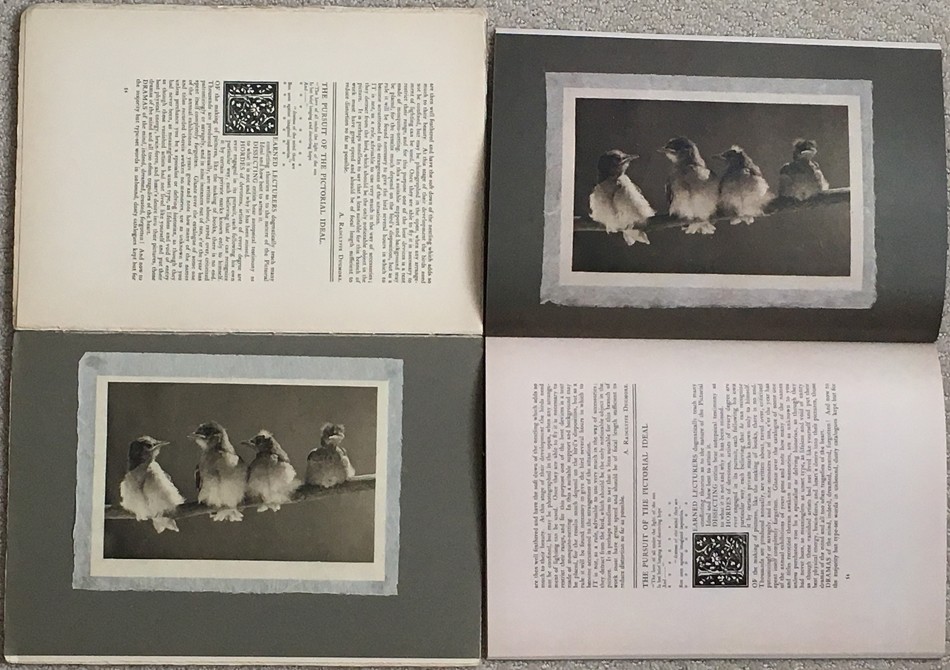 Vintage or Modern? Bottom Left: This mounted photogravure plate in Camera Work I from 1903 titled "A Study in Natural History" is by the American photographer A. Radclyffe Dugmore. This vintage example is opened to show it in relation to the opposing text page in an incomplete copy owned by the PhotoSeed Archive. Upper Right: The same page spread featuring the Dugmore plate in a new issue of Camera Work published as part of a set in May, 2018 and sold by Pierre Vreyen. Keen observers will notice the plates are flipped: this is because Alfred Stieglitz personally hand-tipped the gravure plates into each unique issue of Camera Work with the results sometimes being different in relation to placement on the plate pages. From: PhotoSeed Archive
Vintage or Modern? Bottom Left: This mounted photogravure plate in Camera Work I from 1903 titled "A Study in Natural History" is by the American photographer A. Radclyffe Dugmore. This vintage example is opened to show it in relation to the opposing text page in an incomplete copy owned by the PhotoSeed Archive. Upper Right: The same page spread featuring the Dugmore plate in a new issue of Camera Work published as part of a set in May, 2018 and sold by Pierre Vreyen. Keen observers will notice the plates are flipped: this is because Alfred Stieglitz personally hand-tipped the gravure plates into each unique issue of Camera Work with the results sometimes being different in relation to placement on the plate pages. From: PhotoSeed Archive
1924: (ca.) After 1917, the first known marketing efforts for the journal appear by the E. Weyhe Gallery of New York City. They publish a small prospectus which served as a sales catalogue after buying up remaining copies from Alfred Stieglitz. Scans of an original prospectus owned by PhotoSeed can be seen above. In 2012, one was also included with the sale of a full leather-bound run of the journal by Sotheby’s. The auction house provided the following background on the Weyhe firm as part of the listing:
“New York art dealer and publisher Erhard Weyhe (1882-1972), whose gallery and bookshop on Lexington Avenue promoted not only prints and art books, but also photography. Weyhe and Stieglitz were friends who frequented each other’s gallery and worked with some of the same artists. Laid in the present set’s first volume is a prospectus issued by the Weyhe firm, announcing that ‘we have recently obtained from the publisher a large stock of Camera Work, the remainder of this unique publication, and we are now offering the public a chance to obtain copies, both singly and in sets.” (3.)
1969: The first attempt at a true duplication for the journal was undertaken by Kraus Reprint, (Nendeln/Liechtenstein) and is outlined by scholar Meredith A. Friedman for her 2009 master of arts thesis “Camera Work And The Alfred Stieglitz Collection At The Metropolitan Museum Of Art”:
“Camera Work was published in fifty volumes from 1903 to 1917. In 1969 Kraus Reprint reproduced all fifty issues of Camera Work in a six-volume set. The reprint is not a facsimile, but rather a duplication of the content (text and illustrations) of Camera Work page-by-page. The page size of the reprint editions is slightly smaller than the original issues. In an introductory note, the publishers explain that the reproduction was printed “as a service to scholars. It records the entire content of the original number, but does not attempt to reproduce its visual quality, nor the calibre of its plates.” (32) The Kraus Reprint edition of Camera Work seems to be the first time anyone acknowledged the value of Camera Work from a scholarly perspective.” (Editors note: Hathi Trust Digital Library currently has around 40 of the Kraus issues which can be accessed here.)
(32.) Alfred Stieglitz, Camera Work (Nendeln, Liechtenstein: Kraus Reprint, 1969), edition notice.
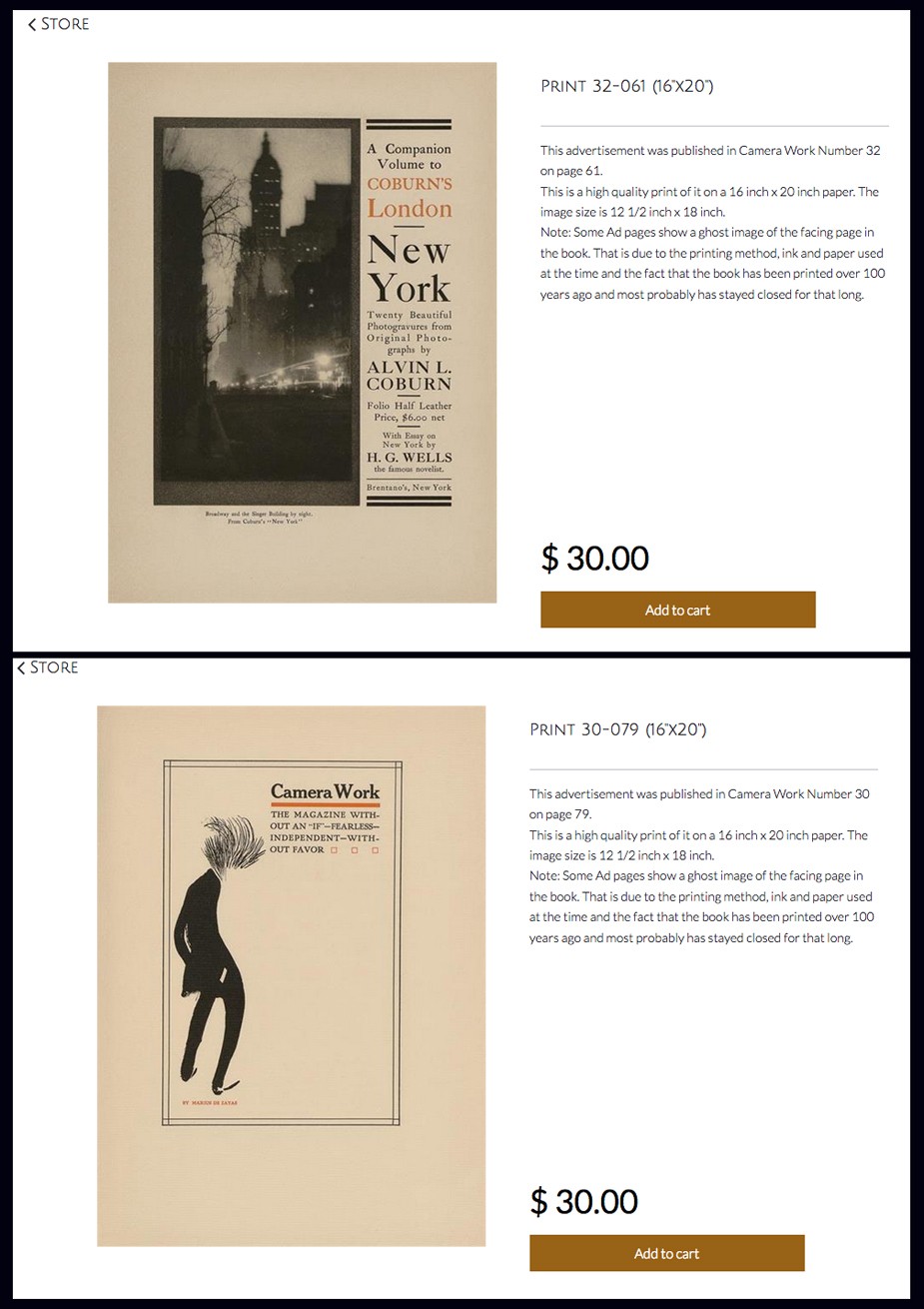 Ready for Framing: In addition to the full run of Camera Work along with a separate index issue, Pierre Vreyen's website cameraworkmagazine.com features approximately 180 individual advertising pages from the journal that can be ordered as 16 x 20" framable art prints for $30 each. At top, a vintage advertisement from Camera Work XXXII featured an actual photogravure from Alvin Langdon Coburn's volume New York. At bottom, an ad shows a full-length caricature of Alfred Stieglitz by the artist Marius De Zayas featured in Camera Work XXX. Courtesy: Pierre Vreyen
Ready for Framing: In addition to the full run of Camera Work along with a separate index issue, Pierre Vreyen's website cameraworkmagazine.com features approximately 180 individual advertising pages from the journal that can be ordered as 16 x 20" framable art prints for $30 each. At top, a vintage advertisement from Camera Work XXXII featured an actual photogravure from Alvin Langdon Coburn's volume New York. At bottom, an ad shows a full-length caricature of Alfred Stieglitz by the artist Marius De Zayas featured in Camera Work XXX. Courtesy: Pierre Vreyen
1973: Friedman continues with the journal’s literature survey:
“Jonathan Green’s Camera Work: A Critical Anthology (1973) is the first significant evaluation of Camera Work, particularly focusing on the articles and text rather than the reproductions. It describes the evolution of the photographic medium through the writing in Camera Work from issue to issue over the fifteen years of its publication. The volume is thoroughly organized with six indexes: biographical information each of the artists, photographers, and writers who contributed to Camera Work and that are featured in his text; a chronological bibliography of works relating to Camera Work and the Photo-Secession; an index of names and subjects appearing in Camera Work; a chronological list of articles published in Camera Work; an index of artists and the issues in which their works appear; and a chronological index of the plates, listing the process by which they were reproduced in Camera Work.”
1973: Scholar Christian Peterson notes the following title which featured a facsimile of the Camera Work cover logo and publishing attribution for Stieglitz in his online sales catalogue for the journal:
Camera Work: A Photographic Quarterly Edited and Published by Alfred Stieglitz, New York, Minneapolis Institute of Arts, 1973. Softcover, 11 x 8 ½ inches, 40 pages, 3 halftone illustrations. This uncommon publication accompanied the exhibition, “I Am an American,” that traveled to over a dozen Minnesota towns in 1973 on the Minneapolis Institute of Arts’ Artmobile. The show included photogravures from Camera Work, plus paintings, drawing, and watercolors by members of the Stieglitz circle. This item includes a facsimile cover of the magazine, brief text by curator Carroll T. Hartwell, and reprints of articles from Camera Work. Most importantly, it features images by James Craig Annan, Alvin Langdon Coburn, and Stieglitz, printed on translucent paper and tipped-in, in a modest effort to replicate the delicate nature of the original gravures. Fine condition. $25. (editor: note: the “gravures” are actually halftones)
1978: Friedman continues with her thesis survey:
“In 1978 Marianne Fulton Margolis published Camera Work: A Pictorial Guide, building upon the thorough indexing in Green’s publication, but instead focusing solely on the images in Camera Work. This was the first time all 559 images from Camera Work were published in a single-volume reference. The images leave much to be desired; all are printed the same size, four to a page, in black and white halftone. As a reference, though, the publication is invaluable. The main part of the book reproduces each image in Camera Work in their exact sequence as published. Like Green, Margolis lists the medium by which the image was reproduced in Camera Work, but she also provides the original medium of the work when known, and also indicates when the reproduction is known to have been created from the artist’s original negative. Further, Margolis provides the reproduction method for every illustration in each issue of Camera Work, whereas Green discussed the plates, and a number of graphics within the text (such as Steichen’s Photo-Secession poster in Camera Work Number 13) which Margolis has not included in her index. Much of this information comes directly from the text of Camera Work. Three additional indexes at the end of the book provide an alphabetical list of artists, titles and portrait sitters, each with corresponding number of the periodical.”
1985: Friedman survey continues:
“This same concern was raised again in 1985 in the exhibition Camera Work: Process and Image organized by the Minneapolis Institute of Arts and accompanied by a catalogue with an essay by Christian A. Peterson that chronicles the use of reproductions throughout the publication of Camera Work, and the response these images provoked in the photographers whose works were reproduced.”
1997: Camera Work- The Complete Illustrations 1903-1917 is published by Benedikt Taschen with an essay in English by Pam Roberts that was additionally translated into German and French for the volume. Along with a full index of all artists represented in the journal and selected texts printed in the rear of the volume, all of the plates are reproduced which were taken from a complete set of Camera Work owned by the Royal Photographic Society, Bath.
Roberts notes in her essay: “Camera Work fulfilled many functions. On one level, it began as the last outpost of the confluence of Symbolist art, photography and literature, and ended as a messenger of Modernism. On another level, it was a non-concurrent exhibition catalogue for 291 and the publicity machine for the Photo-Secession.”
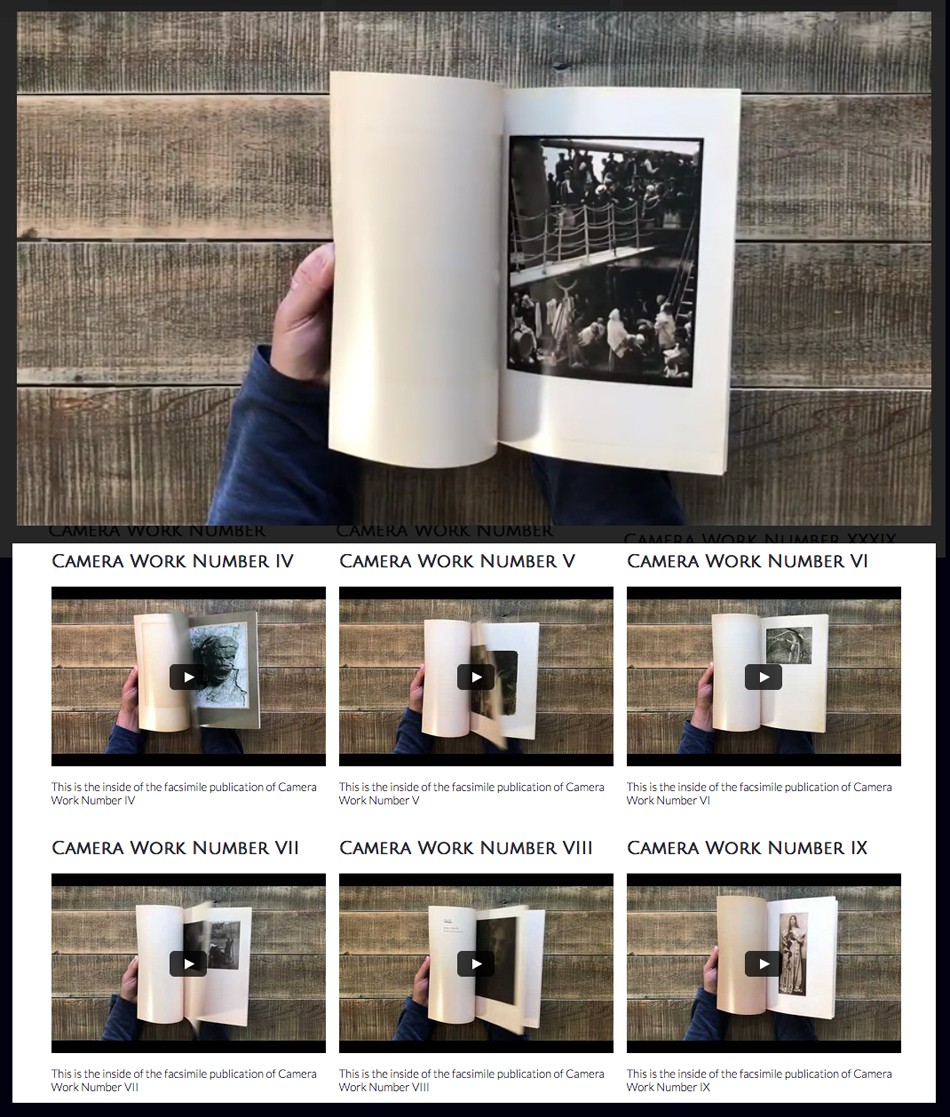 Pierre wears a Blue Shirt: Each issue of the full run of the newly re-issued Camera Work magazine plus a new separate index issue published in May, 2018 is featured in short video clips from back to front by Pierre Vreyen at his website cameraworkmagazine.com. At top, "The Steerage" by Alfred Stieglitz in Camera Work XXXVI. Courtesy Pierre Vreyen
Pierre wears a Blue Shirt: Each issue of the full run of the newly re-issued Camera Work magazine plus a new separate index issue published in May, 2018 is featured in short video clips from back to front by Pierre Vreyen at his website cameraworkmagazine.com. At top, "The Steerage" by Alfred Stieglitz in Camera Work XXXVI. Courtesy Pierre Vreyen
Friedman’s thesis also comments on the 15th anniversary edition of this work: “An alternate version of this book, Camera Work: The Complete Photographs, published in 2008 for the l5th anniversary of Taschen, features reproductions of every photograph in Camera Work, but not every illustration as its predecessor does.”
2003: “Camera Work: A Centennial Celebration” is published. Friedman comments:
”In celebration of the 100th anniversary of the publication of Camera Work, a traveling exhibition was organized by Stephen Perloff, editor of The Photo Review and The Photograph Collector. A double issue of The Photo Review was published as a catalogue and featured essays by Perloff along with Peter C. Bunnell, Lucy Bowdich, Barbara L. Michaels, and Luis Nadeau.” (33.)
33. Perloff, Stephen, ed. “Camera Work: A Centennial Celebration.” Exhibition catalogue. The Photo Review 26, no. 1-2, 2003.
Camera Work Resources & Scholarship on the Web
- Wikipedia: always a good resource if you are just getting your feet wet in first learning about Camera Work. Link
- Modernist Journal Project: originally founded at Brown University in 1995 to create an online periodicals database, the entire run of Camera Work, using vintage copies from Princeton University, has been digitized in the last five years and posted online. Brown teamed with The University of Tulsa for the effort, which lacks only six photographic plates-Gertrude Käsebier’s “Portrait (Miss N)” and “Red Man” (CW 1: 11, 13), A. Radclyffe Dugmore’s “Study in Natural History” (CW 1: 55), Eduard Steichen’s “Solitude” and “Poster Lady” (CW 14s: 33, 35), and Steichen’s “The Photographer’s Best Model: G. Bernard Shaw” (CW 42-43: 39). Link
- Photogravure.com: Site owner and collector Mark Katzman has made all of the gorgeous photogravure plates (as well as most of the halftone plates) throughout the entire run of Camera Work accessible from his personal collection in the newly relaunched version of his site. Link
- Heidelberg University Library in conjunction with The University of Zurich launches their digitization efforts to the web in March, 2018: “all fifty regular and three special issues of Camera Work are digitized to the highest standards”. Link
- Camera Work: Inside/Out: Under the guidance of Professor Dr. Bettina Gockel, the principal investigator for the project, the University of Zurich from 2015-18 launches this research project in conjunction with the Institute of Art History at the university. Link
- Video: Camera Work – Institute of Art History University of Zurich: With a running length of about 5.5 minutes, this video produced as part of “Camera Work: Inside/Out” is a wonderful tribute to the enduring legacy and importance of the journal, and a fitting end to our post. Link
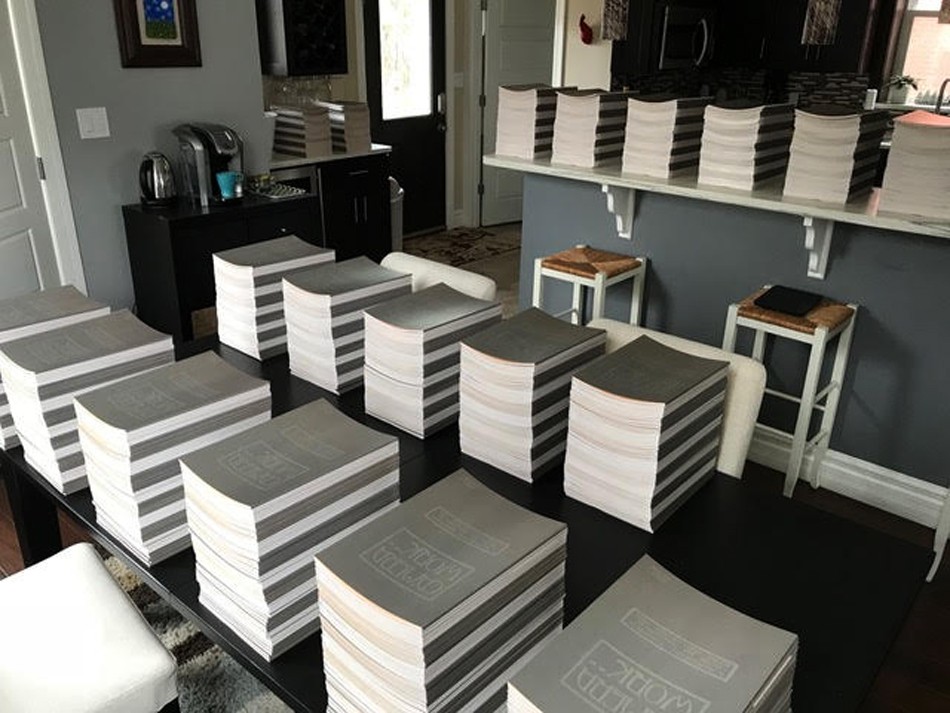 Editor, Publisher & Shipper: As seen here, St. Louis, MO resident Pierre Vreyen told PhotoSeed: "I picked up 25 sets of Camera Work from the printer yesterday. 1275 books!!! That’s a lot of books spread around my house. I am currently stacking them all in sets…" Well done, Pierre and good luck on your new endeavor I say! Courtesy Pierre Vreyen
Editor, Publisher & Shipper: As seen here, St. Louis, MO resident Pierre Vreyen told PhotoSeed: "I picked up 25 sets of Camera Work from the printer yesterday. 1275 books!!! That’s a lot of books spread around my house. I am currently stacking them all in sets…" Well done, Pierre and good luck on your new endeavor I say! Courtesy Pierre Vreyen
Notes:
1. Letter excerpt: in auction listing by RR Auction, Amherst, NH April, 2018-lot passed- #0537. Additionally, the first two sentences of this letter cited in footnote #15 by Lori Cole for her essay “Camera Work: Forming Avant-Garde New York” published in the 2013 volume The Aesthetics of Matter: Modernism, the Avant-Garde and Material Exchange with cited source being the Alfred Stieglitz/Georgia O’Keeffe Archive at Yale University’s Beinecke Rare Book Library. (p. 186) (Note: the 2008 volume edited by Robert Wojtowicz titled Mumford on Modern Art in the 1930s states carbon copies of letters, believed to include this one sent by Stieglitz to Mumford, are contained within the Alfred Stieglitz correspondence files at the Beinecke.) The actual bonfire set by Stieglitz is corroborated somewhat in a description by Sue Davidson Lowe, the grandniece of Stieglitz, who writes in her volume: Stieglitz-A Memoir/Biography (1983) that in 1929, when Stieglitz was at Lake George and experiencing an emotional helplessness because he had not heard from Georgia O’Keeffe for several weeks, took to the cathartic act of burning: “an accumulation of papers-books and pamphlets, magazines (including many issues of Camera Work), negatives, and prints.” p. 294
2. ALS signed “Stieglitz,” three pages on two sheets, October 15, 1935, in part. (Stieglitz to Lewis Mumford) From auction listing: RR Auction, Amherst, NH April, 2018-lot passed- #0537.
3. ‘CAMERA WORK: A PHOTOGRAPHIC QUARTERLY’ Alfred Stieglitz, Editor: Sotheby’s: 03 OCTOBER 2012: Lot 55
Kodak City: the Sequel
Posted April 2018 in Cameras, Conservation, Exhibitions, History of Photography, Photographic Preservation, Photography, Publishing
Speaking of photography in general, of which this website is particularly enamored of, our recent visit to Rochester, New York and attendance in the three-day conference “PhotoHistory/PhotoFuture” sponsored and organized by RIT Press and The Wallace Center at the Rochester Institute of Technology gave new meaning to their claims for the medium: “there has never been more of it than there is today.” That might be stating the obvious, especially in 2018, but the new meaning part was my own takeaway and inspiration.
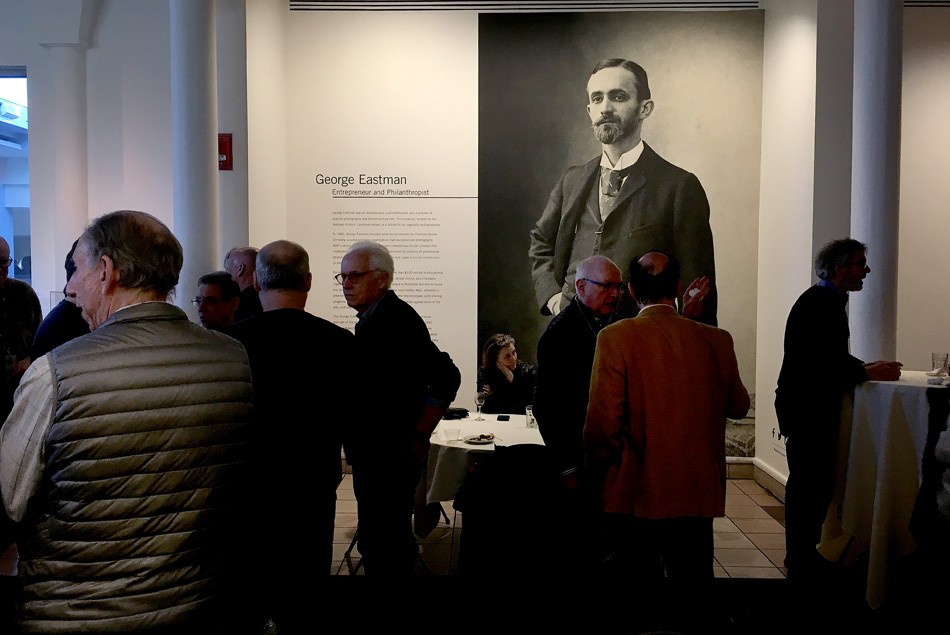 By George, Still Relevant: During a reception at the George Eastman Museum for conference attendees, a young George Eastman,(1854-1932) who founded the Eastman Kodak Company, looms larger than life in a photograph taken in 1890 by Nadar. Entrepreneur and Philanthropist are emphasized on the wall label, and with good reason. From the museum's website:"The George Eastman Museum is located in Rochester, New York, on the estate of George Eastman, the pioneer of popular photography and motion picture film. Founded in 1947 as an independent nonprofit institution, it is the world’s oldest photography museum and one of the oldest film archives. The museum holds unparalleled collections—encompassing several million objects—in the fields of photography, cinema, and photographic and cinematographic technology, and photographically illustrated books. The institution is also a longtime leader in film preservation and photographic conservation." David Spencer for PhotoSeed Archive
By George, Still Relevant: During a reception at the George Eastman Museum for conference attendees, a young George Eastman,(1854-1932) who founded the Eastman Kodak Company, looms larger than life in a photograph taken in 1890 by Nadar. Entrepreneur and Philanthropist are emphasized on the wall label, and with good reason. From the museum's website:"The George Eastman Museum is located in Rochester, New York, on the estate of George Eastman, the pioneer of popular photography and motion picture film. Founded in 1947 as an independent nonprofit institution, it is the world’s oldest photography museum and one of the oldest film archives. The museum holds unparalleled collections—encompassing several million objects—in the fields of photography, cinema, and photographic and cinematographic technology, and photographically illustrated books. The institution is also a longtime leader in film preservation and photographic conservation." David Spencer for PhotoSeed Archive
In present day Kodak city, the power of ideas relating to what made this place significant as an imaging industrial behemoth still exists, but has now gone in a new direction. With all due apologies, but the pun indeed appropriate, a snapshot of those ideas put forth by the conference attendees and speakers shows their passion for the medium’s minutiae both preserves and continues this essential democratic language. Those of memories past surely, but more and more the future in the form of ones and zeroes hurtling forward.
Although the “Big Yellow” of Rochester’s past is long gone, the ideas nourishing photography’s entire corpus continues apace, an alternate reality both present and future. For those curious enough, the RIT conference program along with a list of presenters can be found here, along with a few photos from the weekend courtesy of yours truly. David Spencer-
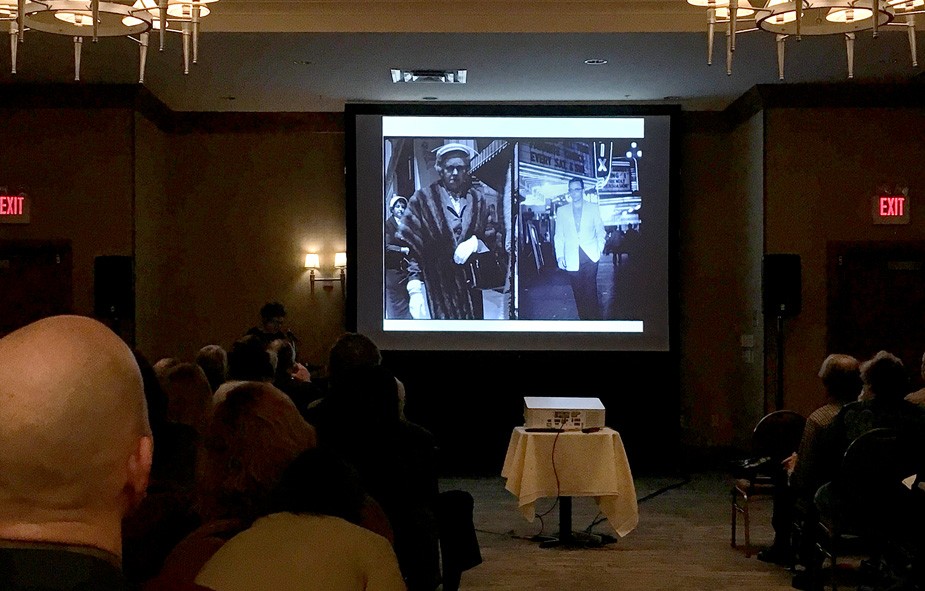 Documentary photography practiced as commerce on busy streets around the world, a genre roughly known as "Movie Snaps" because of the retrofitted movie cameras used in their making, was part of a fascinating presentation under the working title “Street Vendor Portraits Around the World: Czernowitz, Capetown, San Francisco, More!” given by independent scholar Mary Panzar of Rochester. Here, the hybrid look of Winogrand meeting Arbus becomes a document in a projected frame of a woman sporting fur and white gloves at left while a gentleman unaware at right emerges to flash and instant celebrity from a movie theatre on a nighttime street. David Spencer for PhotoSeed Archive
Documentary photography practiced as commerce on busy streets around the world, a genre roughly known as "Movie Snaps" because of the retrofitted movie cameras used in their making, was part of a fascinating presentation under the working title “Street Vendor Portraits Around the World: Czernowitz, Capetown, San Francisco, More!” given by independent scholar Mary Panzar of Rochester. Here, the hybrid look of Winogrand meeting Arbus becomes a document in a projected frame of a woman sporting fur and white gloves at left while a gentleman unaware at right emerges to flash and instant celebrity from a movie theatre on a nighttime street. David Spencer for PhotoSeed Archive
 Triptych in the Dark: Left: During his presentation “Did Talbot Make Daguerreotypes?”, the eminence of English photography pioneer William Henry Fox Talbot (1800-1877) is shown here by an image most in attendance had seen, yet Grant Romer- formerly of the Eastman House but now Founding Director of the Academy of Archaic Imaging, challenged us with another view: a decidedly unflattering profile of the paper/negative pioneer he rightly remarked might have made for a different public perception for the emerging medium had it been the lone evidence of his existence. Middle: a quote of photographic philosophy by American writer Susan Sontag (1933-2004) struck this observer as particularly relevant in the present day- University of Illinois Springfield professors Kathy Petitte Novak and Brytton Bjorngaard used it as supporting evidence while speaking on “The Blurring Distinctions of Taking versus Making Photographs: Teaching Photography in a Digital Culture”. Right: the appropriated late Victorian era reality of the dark underbelly of a small Wisconsin town through the lens of Black River Falls photographer Charles Van Schaik repurposed by author Michael Lesy in his 1973 cult classic "Wisconsin Death Trip" was supporting material for Nicolette Bromberg of the University of Washington, who argued photographic archivists need to understand context in her paper “Loss of Vision: How Art Historians and Critics Misjudge Early 20th Century Photography and How Early Photographers Along with Art Museums and Archives Help to Obscure the Photographic Record”. David Spencer for PhotoSeed Archive
Triptych in the Dark: Left: During his presentation “Did Talbot Make Daguerreotypes?”, the eminence of English photography pioneer William Henry Fox Talbot (1800-1877) is shown here by an image most in attendance had seen, yet Grant Romer- formerly of the Eastman House but now Founding Director of the Academy of Archaic Imaging, challenged us with another view: a decidedly unflattering profile of the paper/negative pioneer he rightly remarked might have made for a different public perception for the emerging medium had it been the lone evidence of his existence. Middle: a quote of photographic philosophy by American writer Susan Sontag (1933-2004) struck this observer as particularly relevant in the present day- University of Illinois Springfield professors Kathy Petitte Novak and Brytton Bjorngaard used it as supporting evidence while speaking on “The Blurring Distinctions of Taking versus Making Photographs: Teaching Photography in a Digital Culture”. Right: the appropriated late Victorian era reality of the dark underbelly of a small Wisconsin town through the lens of Black River Falls photographer Charles Van Schaik repurposed by author Michael Lesy in his 1973 cult classic "Wisconsin Death Trip" was supporting material for Nicolette Bromberg of the University of Washington, who argued photographic archivists need to understand context in her paper “Loss of Vision: How Art Historians and Critics Misjudge Early 20th Century Photography and How Early Photographers Along with Art Museums and Archives Help to Obscure the Photographic Record”. David Spencer for PhotoSeed Archive
 Photographic Preservation: With a mission statement stating they are the "world leader in the development and deployment of sustainable practices for the preservation of images and cultural heritage", conference attendees toured the Image Permanence Institute, (www.imagepermanenceinstitute.org) which opened in 1985 as an academic research laboratory within the College of Imaging Arts and Sciences at RIT. For many visitors, IPI is known for their Graphics Atlas, (www.graphicsatlas.org) an online resource that helps identify photographic and other process print types. In front of a table with various displayed print types including a row of portraits toned with Polysulfide & Selenium Toner, Institute senior research scientist Douglas Nishimura at left chats with a visitor. David Spencer for PhotoSeed Archive
Photographic Preservation: With a mission statement stating they are the "world leader in the development and deployment of sustainable practices for the preservation of images and cultural heritage", conference attendees toured the Image Permanence Institute, (www.imagepermanenceinstitute.org) which opened in 1985 as an academic research laboratory within the College of Imaging Arts and Sciences at RIT. For many visitors, IPI is known for their Graphics Atlas, (www.graphicsatlas.org) an online resource that helps identify photographic and other process print types. In front of a table with various displayed print types including a row of portraits toned with Polysulfide & Selenium Toner, Institute senior research scientist Douglas Nishimura at left chats with a visitor. David Spencer for PhotoSeed Archive
 Conference participants attended the exhibition "The Luminous Print: An Appreciation of Photogravure" organized by David Pankow, Curator Emeritus for the Cary Graphic Arts Collection at RIT now running through June 15, 2018. With beginnings in intaglio printing by artists working in the late 15th Century, photogravure's historical timeline which evolved by the 19th Century as a medium for "images from real life" is showcased by superb examples featuring plates from bound volumes, portfolios and individual works. The pleasure in real life can be seconded by this attendee, with the following observation from the catalogue true to form: "enjoy this exhibition for the beauty of its images alone and discover why it has been said that a photogravure print is endowed with a luminosity unequalled by any other process."David Spencer for PhotoSeed Archive
Conference participants attended the exhibition "The Luminous Print: An Appreciation of Photogravure" organized by David Pankow, Curator Emeritus for the Cary Graphic Arts Collection at RIT now running through June 15, 2018. With beginnings in intaglio printing by artists working in the late 15th Century, photogravure's historical timeline which evolved by the 19th Century as a medium for "images from real life" is showcased by superb examples featuring plates from bound volumes, portfolios and individual works. The pleasure in real life can be seconded by this attendee, with the following observation from the catalogue true to form: "enjoy this exhibition for the beauty of its images alone and discover why it has been said that a photogravure print is endowed with a luminosity unequalled by any other process."David Spencer for PhotoSeed Archive
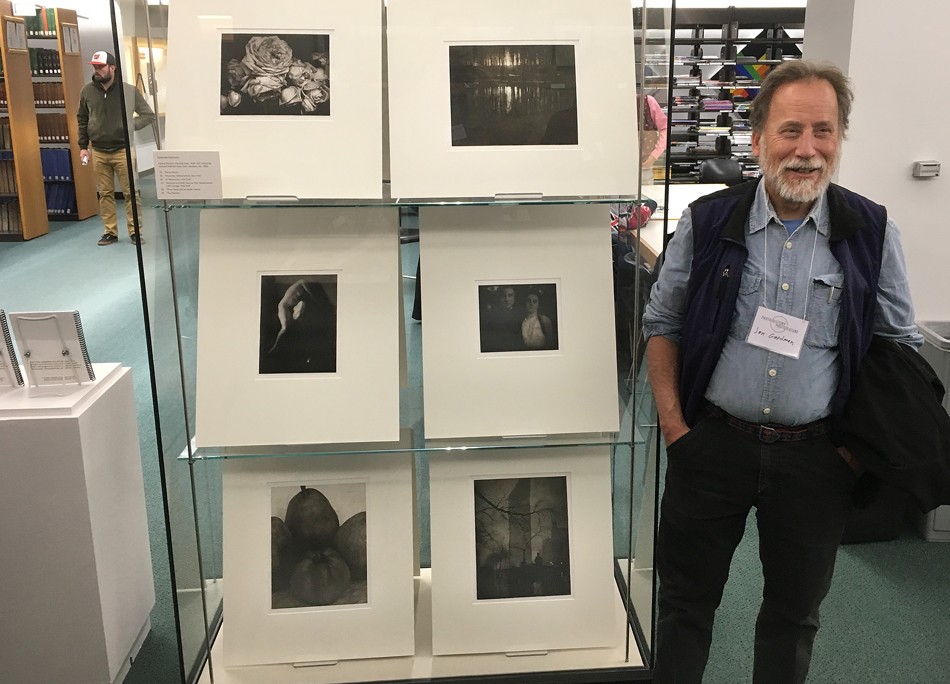 Royal Visit: As an added bonus, conference attendees viewing "The Luminous Print" could rub shoulders with Massachusetts resident Jon Goodman, a master craftsman who has worked full time since 1976 as a photogravure printer specializing in the Talbot Klic photogravure technique . Beginning in 1980 through the Photogravure Workshop, a division of the Aperture Publishing Foundation and their namesake Aperture magazine and the Paul Strand Foundation, Jon has produced sumptuous, superb, and collectable portfolios of the early work of Paul Strand, Edward Steichen, and British photography. His mission continues today in his Florence, MA atelier along with a new interest: carbon printing. Displayed are six of Jon's gravure plates featuring the pictorial work of Edward Steichen from the 1981 Aperture portfolio: "Edward Steichen; The Early Years, 1900-1927". Top to bottom left to right: "Heavy Roses", "Moonrise, Mamaroneck, New York", "In Memoriam, New York", "Steichen and Wife Clara on their Honeymoon, Lake George, New York", "Three Pears and an Apple, France", "The Flatiron". Visit jgoodgravure.com and gravureportfolios.com for more information. David Spencer for PhotoSeed Archive
Royal Visit: As an added bonus, conference attendees viewing "The Luminous Print" could rub shoulders with Massachusetts resident Jon Goodman, a master craftsman who has worked full time since 1976 as a photogravure printer specializing in the Talbot Klic photogravure technique . Beginning in 1980 through the Photogravure Workshop, a division of the Aperture Publishing Foundation and their namesake Aperture magazine and the Paul Strand Foundation, Jon has produced sumptuous, superb, and collectable portfolios of the early work of Paul Strand, Edward Steichen, and British photography. His mission continues today in his Florence, MA atelier along with a new interest: carbon printing. Displayed are six of Jon's gravure plates featuring the pictorial work of Edward Steichen from the 1981 Aperture portfolio: "Edward Steichen; The Early Years, 1900-1927". Top to bottom left to right: "Heavy Roses", "Moonrise, Mamaroneck, New York", "In Memoriam, New York", "Steichen and Wife Clara on their Honeymoon, Lake George, New York", "Three Pears and an Apple, France", "The Flatiron". Visit jgoodgravure.com and gravureportfolios.com for more information. David Spencer for PhotoSeed Archive
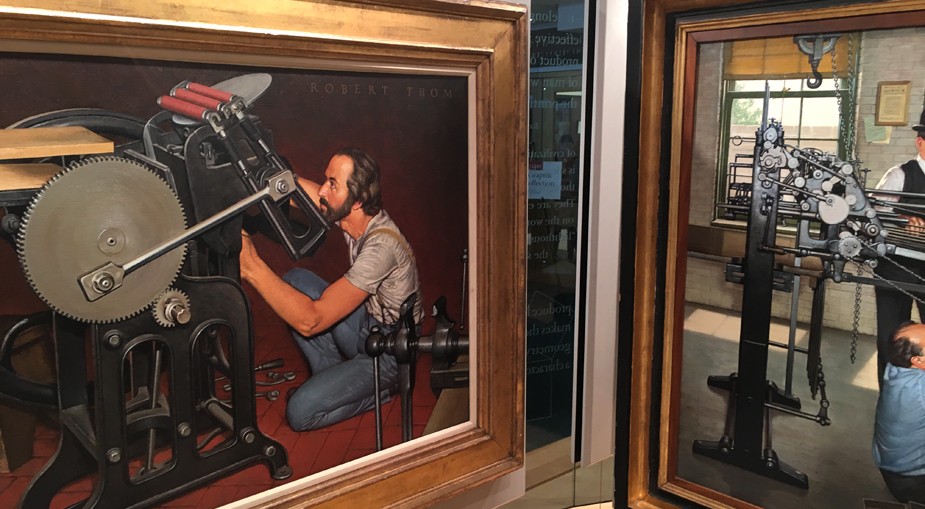 History of Printing: A series of oil paintings by three artists originally commissioned in 1966 by the Kimberly-Clark Corporation commemorating "Graphic Communications through the Ages" hangs within the offices of the RIT Press ( www.rit.edu/press/ ) and the adjoining Cary Graphic Arts Collection at The Wallace Center. This painting shows a detail of the work "George P. Gordon and the Platen Press" done by American illustrator Robert A. Thom, (1915-1979) with a detail at right by Thom: "Ira Rubel and the Offset Press". David Spencer for PhotoSeed Archive
History of Printing: A series of oil paintings by three artists originally commissioned in 1966 by the Kimberly-Clark Corporation commemorating "Graphic Communications through the Ages" hangs within the offices of the RIT Press ( www.rit.edu/press/ ) and the adjoining Cary Graphic Arts Collection at The Wallace Center. This painting shows a detail of the work "George P. Gordon and the Platen Press" done by American illustrator Robert A. Thom, (1915-1979) with a detail at right by Thom: "Ira Rubel and the Offset Press". David Spencer for PhotoSeed Archive
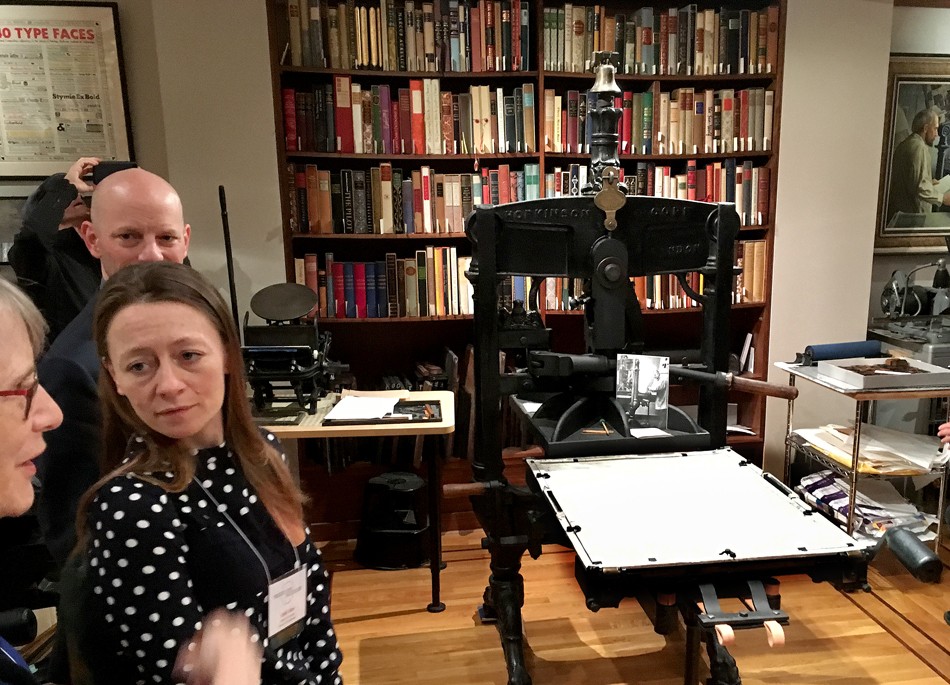 Making an Impression: Taking center stage for visitors is the famed Kelmscott/Goudy iron hand-press featured among other working presses in the Arthur M. Lowenthal Memorial Pressroom within the Cary Graphics Arts Collection at RIT. Visitors learned it was first owned by the English printer William Morris and then Frederic Goudy, two giants of the letterpress printing art. The press was built in London in 1891 by Hopkinson & Cope- an Improved Albion model (No. 6551). Now featuring around 40,000 fine and rare volumes on graphic communication history and practices, The Cary Collection is considered one of the premier libraries on the subject in the United States. ( library.rit.edu/cary ) David Spencer for PhotoSeed Archive
Making an Impression: Taking center stage for visitors is the famed Kelmscott/Goudy iron hand-press featured among other working presses in the Arthur M. Lowenthal Memorial Pressroom within the Cary Graphics Arts Collection at RIT. Visitors learned it was first owned by the English printer William Morris and then Frederic Goudy, two giants of the letterpress printing art. The press was built in London in 1891 by Hopkinson & Cope- an Improved Albion model (No. 6551). Now featuring around 40,000 fine and rare volumes on graphic communication history and practices, The Cary Collection is considered one of the premier libraries on the subject in the United States. ( library.rit.edu/cary ) David Spencer for PhotoSeed Archive
 Alternate History: The coverage by war photographer Robert Capa (1913-1954) for Life Magazine of American troops landing on Omaha Beach on D-Day during World War II was deconstructed after seven decades of public myth to facts by Staten Island, NY independent critic and historian A. D. Coleman. The first photo critic for the New York Times in 1967 and prolific author of books on photography as well as thousands of articles on the medium, Coleman presented his research during the conference titled “Deconstructing Robert Capa’s D-Day: The Unmaking of a Myth” that recently took place over three years helped by the efforts of war photographer J. Ross Baughman, Rob McElroy and Charles Herrick. As a former photojournalist myself for over three decades, I found his presentation convincing and enlightening: I still remember drying strips of film as a young photographer in large upright darkroom cabinets-the focus of some of the research when it was claimed a Life lab tech had melted Capa's film on deadline- the worst I remember was curled film! Please visit capaddayproject.com to learn more. Malcolm Gladwell, (revisionisthistory.com) are you interested? David Spencer for PhotoSeed Archive
Alternate History: The coverage by war photographer Robert Capa (1913-1954) for Life Magazine of American troops landing on Omaha Beach on D-Day during World War II was deconstructed after seven decades of public myth to facts by Staten Island, NY independent critic and historian A. D. Coleman. The first photo critic for the New York Times in 1967 and prolific author of books on photography as well as thousands of articles on the medium, Coleman presented his research during the conference titled “Deconstructing Robert Capa’s D-Day: The Unmaking of a Myth” that recently took place over three years helped by the efforts of war photographer J. Ross Baughman, Rob McElroy and Charles Herrick. As a former photojournalist myself for over three decades, I found his presentation convincing and enlightening: I still remember drying strips of film as a young photographer in large upright darkroom cabinets-the focus of some of the research when it was claimed a Life lab tech had melted Capa's film on deadline- the worst I remember was curled film! Please visit capaddayproject.com to learn more. Malcolm Gladwell, (revisionisthistory.com) are you interested? David Spencer for PhotoSeed Archive
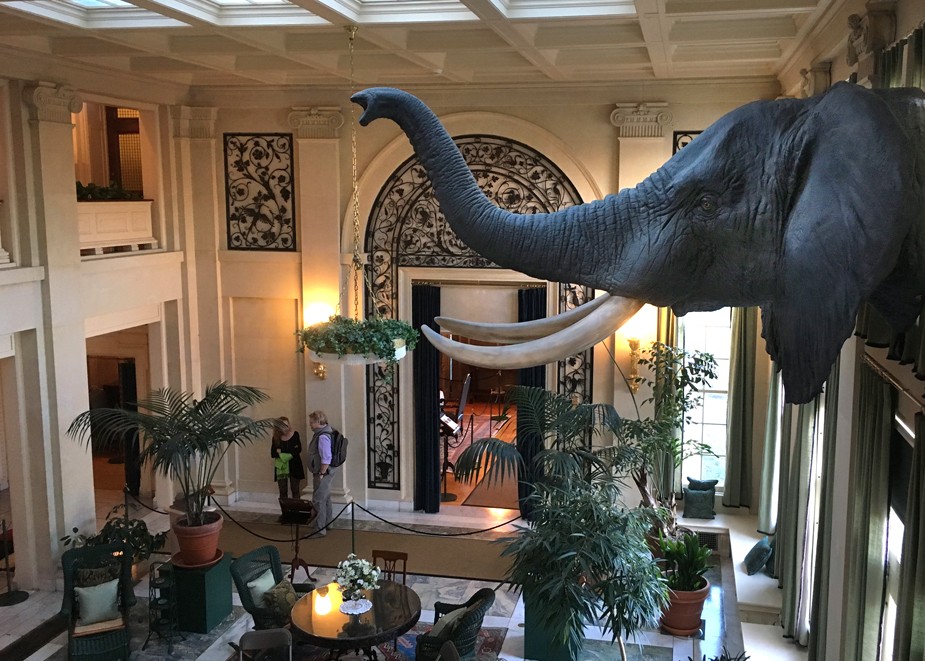 Digital Elephant in Room: Visitors to George Eastman's stately 50-room Colonial revival mansion adjoining the Eastman Museum will always remember the conservatory, where a fiberglass replica mount of an African bull elephant hangs- a conquest by the company founder during a 1928 Sudanese safari. Conveniently- and speaking of elephants in the room, I earlier had thoroughly enjoyed listening and pondering conference presenter Stephen Fletcher's talk: “The Photographic Archivist is Dead, Long Live the Photographic Archivist!”, his call to action for the task of photo archivists in the 21st Century: what do we do and how do we preserve a portion for posterity and history the digital evidence of billions and billions of photographs taken-seemingly, every day? A photographic archivist in the North Carolina collection at the University of North Carolina at Chapel Hill, Fletcher's call to arms would surely have inspired Eastman himself, a hands-on guy who is reported to have overseen every aspect of the construction of his mansion and made sure it contained all the cutting-edge technology of its' day: from the Eastman Museum website: "Beneath this exterior were modern conveniences such as an electrical generator, an internal telephone system with 21 stations, a built-in vacuum cleaning system, a central clock network, an elevator, and a great pipe organ, which made the home itself an instrument, a center of the city’s rich musical life from 1905 until Eastman’s death in 1932. Eastman was involved in every aspect of the construction, paying close attention to detail and requiring the use of high-quality materials." David Spencer for PhotoSeed Archive
Digital Elephant in Room: Visitors to George Eastman's stately 50-room Colonial revival mansion adjoining the Eastman Museum will always remember the conservatory, where a fiberglass replica mount of an African bull elephant hangs- a conquest by the company founder during a 1928 Sudanese safari. Conveniently- and speaking of elephants in the room, I earlier had thoroughly enjoyed listening and pondering conference presenter Stephen Fletcher's talk: “The Photographic Archivist is Dead, Long Live the Photographic Archivist!”, his call to action for the task of photo archivists in the 21st Century: what do we do and how do we preserve a portion for posterity and history the digital evidence of billions and billions of photographs taken-seemingly, every day? A photographic archivist in the North Carolina collection at the University of North Carolina at Chapel Hill, Fletcher's call to arms would surely have inspired Eastman himself, a hands-on guy who is reported to have overseen every aspect of the construction of his mansion and made sure it contained all the cutting-edge technology of its' day: from the Eastman Museum website: "Beneath this exterior were modern conveniences such as an electrical generator, an internal telephone system with 21 stations, a built-in vacuum cleaning system, a central clock network, an elevator, and a great pipe organ, which made the home itself an instrument, a center of the city’s rich musical life from 1905 until Eastman’s death in 1932. Eastman was involved in every aspect of the construction, paying close attention to detail and requiring the use of high-quality materials." David Spencer for PhotoSeed Archive
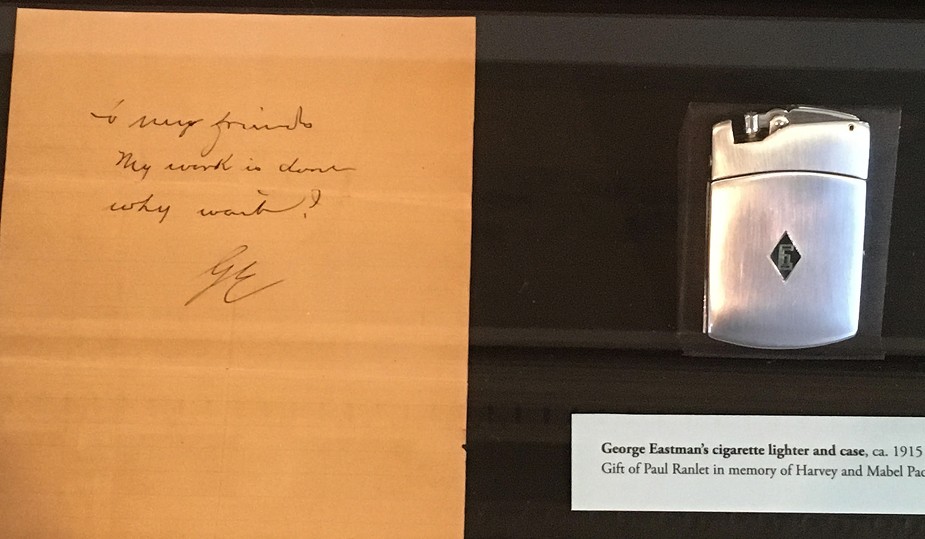 Smoking also Works: Perhaps the most startling object on display in the mansion-at least to those who do not know the intimate details of George Eastman's life- is a facsimile of his 1932 suicide note: "To my friends - My work is done - why wait? GE." Suppressed initially by the Eastman Kodak Company for decades, this news is sobering but important. Eastman had been crippled by a degenerative spinal disease and unable to walk, he shot himself through the heart in his upstairs bedroom. A music lover even after the end, a 1990 New York Times story on the renovation of the mansion noted he "requested a rousing ''Marche Romaine'' by Charles Gounod be played at his funeral". David Spencer for PhotoSeed Archive
Smoking also Works: Perhaps the most startling object on display in the mansion-at least to those who do not know the intimate details of George Eastman's life- is a facsimile of his 1932 suicide note: "To my friends - My work is done - why wait? GE." Suppressed initially by the Eastman Kodak Company for decades, this news is sobering but important. Eastman had been crippled by a degenerative spinal disease and unable to walk, he shot himself through the heart in his upstairs bedroom. A music lover even after the end, a 1990 New York Times story on the renovation of the mansion noted he "requested a rousing ''Marche Romaine'' by Charles Gounod be played at his funeral". David Spencer for PhotoSeed Archive
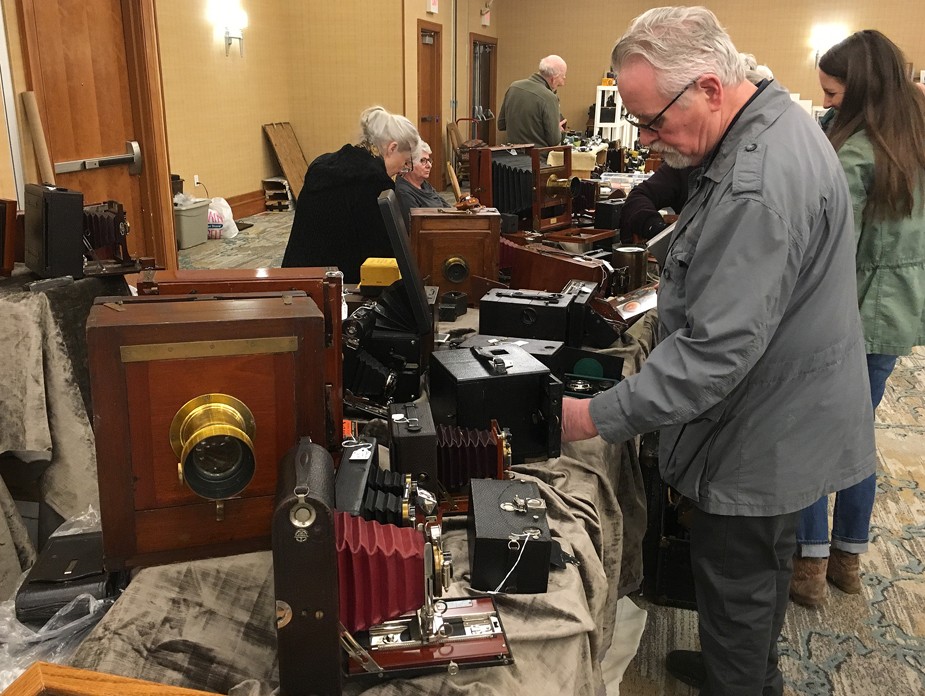 Fancy Box with Hole in It: Collectors and the curious had the opportunity to peruse the physical evidence of the history of photography during the concluding event of the conference, an antiquarian photography show and sale featuring 80 tables of wares including these vintage wooden box and Kodak cameras. Earlier, the RIT Press and Syracuse University Press showed off their latest offerings, including some wonderful photography volumes during the event. David Spencer for PhotoSeed Archive
Fancy Box with Hole in It: Collectors and the curious had the opportunity to peruse the physical evidence of the history of photography during the concluding event of the conference, an antiquarian photography show and sale featuring 80 tables of wares including these vintage wooden box and Kodak cameras. Earlier, the RIT Press and Syracuse University Press showed off their latest offerings, including some wonderful photography volumes during the event. David Spencer for PhotoSeed Archive
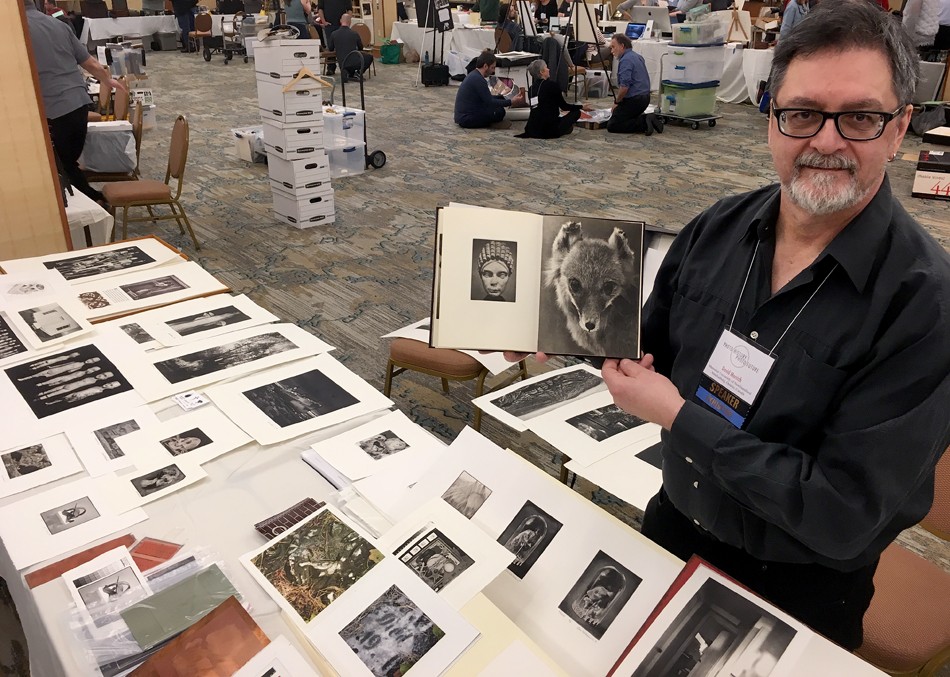 Learned from Jon Goodman: During the antiquarian photography show and sale, Ontario-based visual artist David Morrish, co-author along with Marlene MacCallum of the 2003 volume "Copper Plate Photogravure: Demystifying the Process", shows off a page spread of original photogravures from his 2004 Deadcat Press imprint "Gaze" he was selling along with other work during the antiquarian photography show and sale. Earlier in the conference, Morrish and visual artist MacCallum, former professor in the Visual Arts Program at Memorial University of Newfoundland, presented on "Photogravure: Then and Now" highlighting the gravure process while showing how the medium’s ongoing relevance to contemporary art practice has influenced their own work in the production of print suites and artists’ books. Learn more at marlenemaccallum.com and davidmorrish.com. David Spencer for PhotoSeed Archive
Learned from Jon Goodman: During the antiquarian photography show and sale, Ontario-based visual artist David Morrish, co-author along with Marlene MacCallum of the 2003 volume "Copper Plate Photogravure: Demystifying the Process", shows off a page spread of original photogravures from his 2004 Deadcat Press imprint "Gaze" he was selling along with other work during the antiquarian photography show and sale. Earlier in the conference, Morrish and visual artist MacCallum, former professor in the Visual Arts Program at Memorial University of Newfoundland, presented on "Photogravure: Then and Now" highlighting the gravure process while showing how the medium’s ongoing relevance to contemporary art practice has influenced their own work in the production of print suites and artists’ books. Learn more at marlenemaccallum.com and davidmorrish.com. David Spencer for PhotoSeed Archive
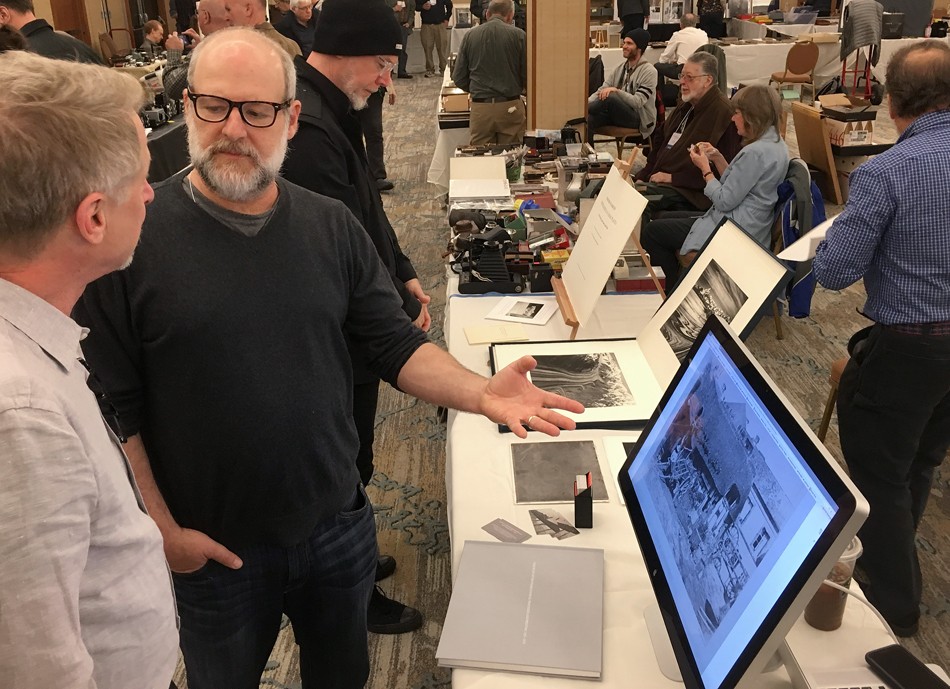 Future with a Past: St. Louis resident and commercial photographer Mark Katzman, the key force in proselytizing for the medium and beauty of hand-pulled photogravure worldwide through his website Photogravure.com, speaks with conference speaker Jeff Rosen during the antiquarian photography show and sale. Curious to learn what a real photogravure is, unlike the many who simply use the term-wrongly-to sell you something not what they claim? Head over to his newly redesigned site, where the mission statement is: "Peeling back a layer of the history of photography, this site examines the role that photogravure has played in shaping our shared visual experience. Through exploring thousands of examples, we learn about the relentless and ambitious 19th century pursuit to reproduce photographs in ink and discover the exquisite, sublime process that resulted. It is our hope that this site firmly establishes photogravure as not only one of the most under-recognized photographic processes, but also an important and beautiful art." David Spencer for PhotoSeed Archive
Future with a Past: St. Louis resident and commercial photographer Mark Katzman, the key force in proselytizing for the medium and beauty of hand-pulled photogravure worldwide through his website Photogravure.com, speaks with conference speaker Jeff Rosen during the antiquarian photography show and sale. Curious to learn what a real photogravure is, unlike the many who simply use the term-wrongly-to sell you something not what they claim? Head over to his newly redesigned site, where the mission statement is: "Peeling back a layer of the history of photography, this site examines the role that photogravure has played in shaping our shared visual experience. Through exploring thousands of examples, we learn about the relentless and ambitious 19th century pursuit to reproduce photographs in ink and discover the exquisite, sublime process that resulted. It is our hope that this site firmly establishes photogravure as not only one of the most under-recognized photographic processes, but also an important and beautiful art." David Spencer for PhotoSeed Archive
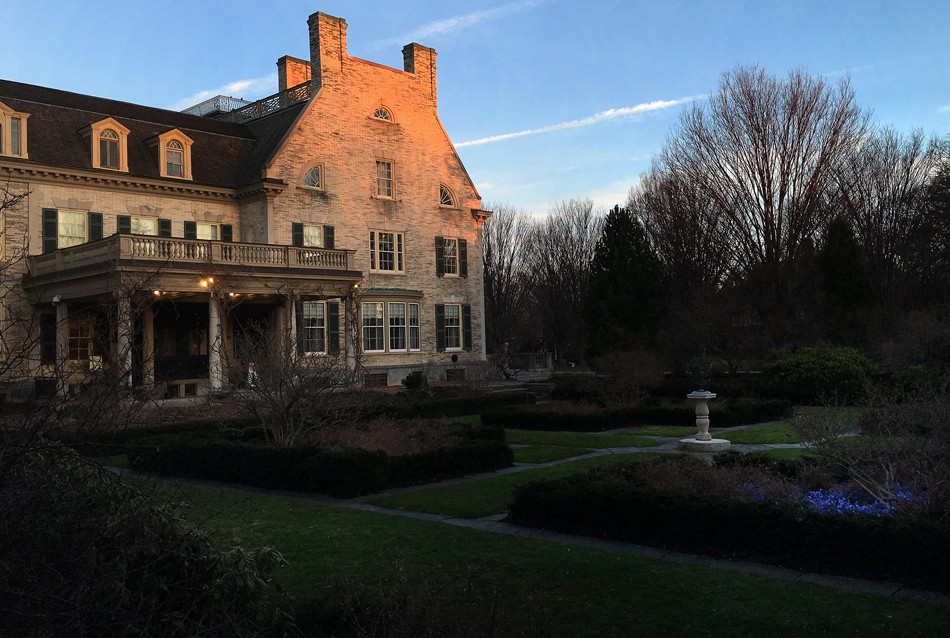 Keeper of Memories: Located at 900 East Ave. in Rochester, New York, the George Eastman Museum, along with a section of his original mansion and gardens on 8.5 acres constructed beginning in 1902, is a grand American repository for the study of photography past, present and future. Besides a growing archive of over 400,000 photographic objects spanning the history of the medium, the museum also features 16,000 + examples of photographic and cinematographic technology- the world's largest. For those interested in the printed legacy, the accessible Richard and Ronay Menschel Library is also onsite, with a special collections and archive division housing "manuscripts, papers, and ephemera, including those of Alvin Langdon Coburn, Lewis W. Hine, Southworth and Hawes, and Edward Steichen, among other photographers, collectors, and inventors." Curious? eastman.org. David Spencer for PhotoSeed Archive
Keeper of Memories: Located at 900 East Ave. in Rochester, New York, the George Eastman Museum, along with a section of his original mansion and gardens on 8.5 acres constructed beginning in 1902, is a grand American repository for the study of photography past, present and future. Besides a growing archive of over 400,000 photographic objects spanning the history of the medium, the museum also features 16,000 + examples of photographic and cinematographic technology- the world's largest. For those interested in the printed legacy, the accessible Richard and Ronay Menschel Library is also onsite, with a special collections and archive division housing "manuscripts, papers, and ephemera, including those of Alvin Langdon Coburn, Lewis W. Hine, Southworth and Hawes, and Edward Steichen, among other photographers, collectors, and inventors." Curious? eastman.org. David Spencer for PhotoSeed Archive
Spring
Posted March 2018 in Fashion Photography, Significant Photographers
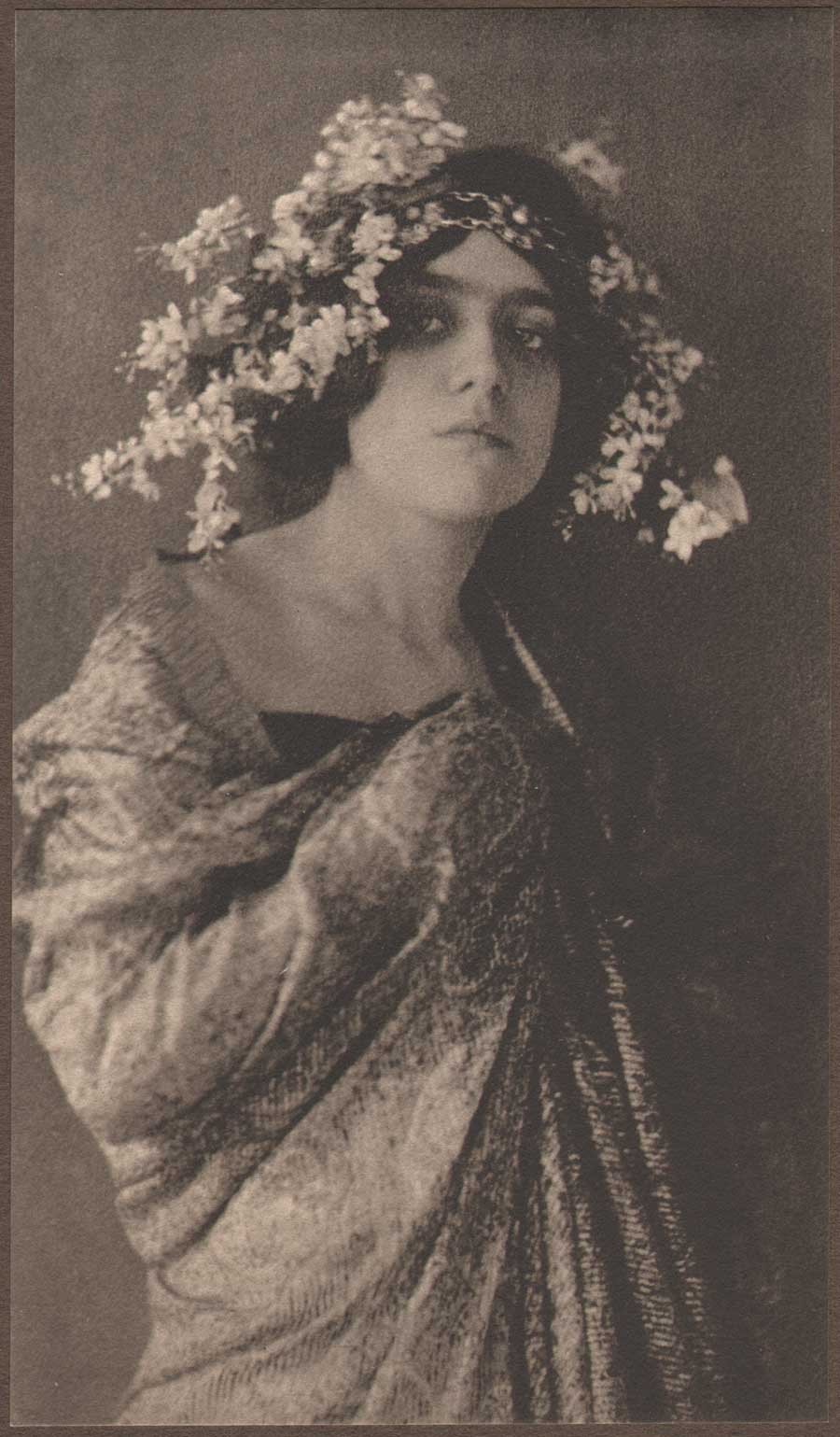 "Spring": Frances Benjamin Johnston, American:1864-1952: vintage photogravure: 1903: 20.6 x 11.9 | 35.5 x 27.7 cm: The work is one of 40 taken from the portfolio titled the "Vollgros Collection of Masterpieces of American Photographs" published in Chicago. The unknown model, with cherry or apple blossoms in her hair, bears a passing resemblance to the poster artist Ethel Reed. "Spring" also appeared as a halftone text illustration in the October, 1898 issue of Camera Notes (V.II, No. 2) published by the New York Camera Club. From: PhotoSeed Archive
"Spring": Frances Benjamin Johnston, American:1864-1952: vintage photogravure: 1903: 20.6 x 11.9 | 35.5 x 27.7 cm: The work is one of 40 taken from the portfolio titled the "Vollgros Collection of Masterpieces of American Photographs" published in Chicago. The unknown model, with cherry or apple blossoms in her hair, bears a passing resemblance to the poster artist Ethel Reed. "Spring" also appeared as a halftone text illustration in the October, 1898 issue of Camera Notes (V.II, No. 2) published by the New York Camera Club. From: PhotoSeed ArchiveSugaring
Posted March 2018 in Documentary Photography, Significant Photographers
“Of all that long season of snow, I remember most pleasantly the days that were sweetened with the sugar-making. When the sun was lifting his course in the clearing sky, and March had got the temper of the lamb, and the frozen pulses of the forest had begun to stir, the great kettle was mounted in the yard and all gave a hand to the washing of spouts and buckets.
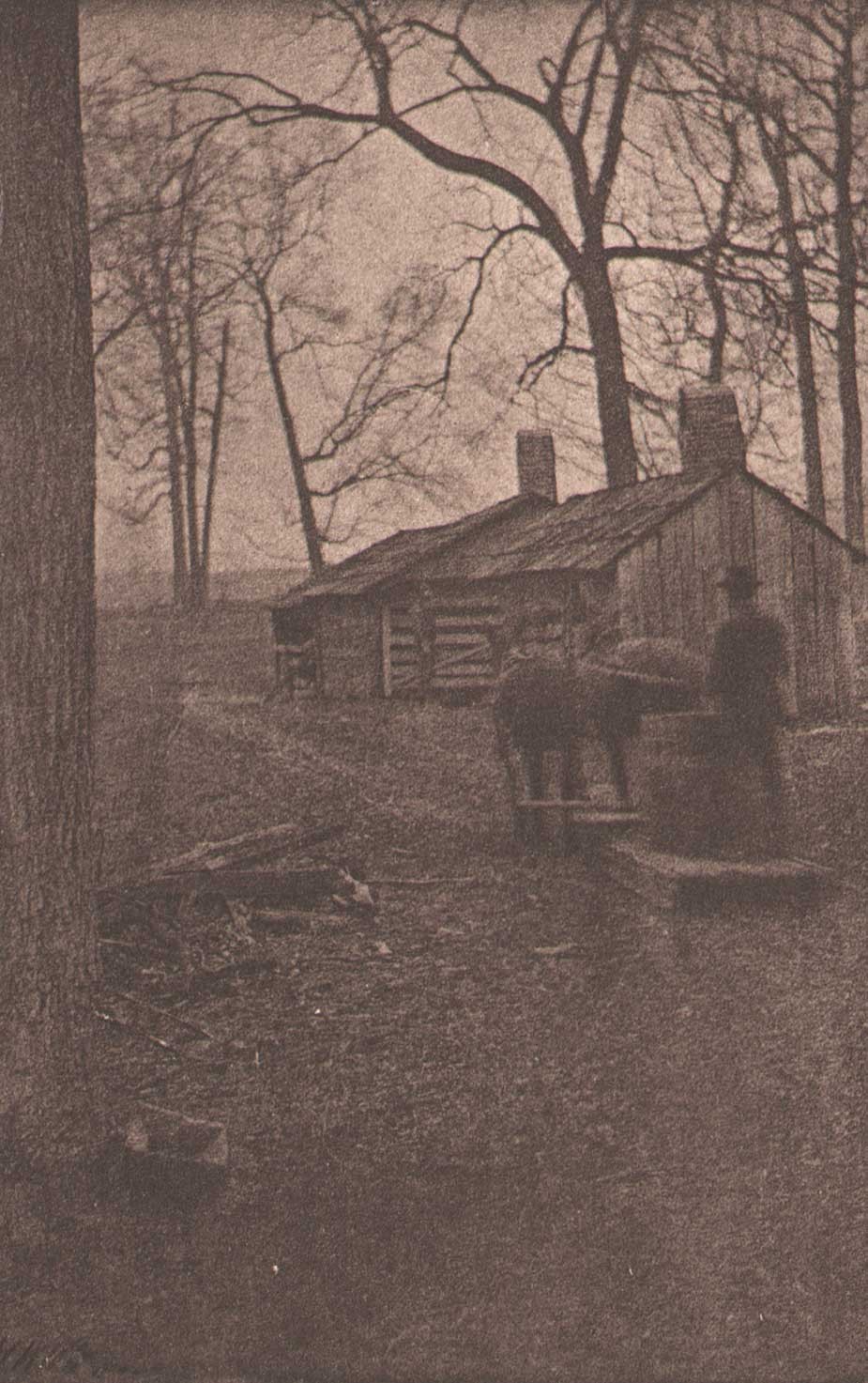 "The Sugar Camp": Clarence H. White, American: 1903: vintage hand-pulled photogravure. 12.2 x 7.7 | 20.0 x 13.9 cm. A team of horses pulls a wooden sled guided by a sugar camp worker and carrying a barrel of tree sap to a sugar shack in the distance. The gravure was included in a special edition of the best selling novel Eben Holden written by Irving Bacheller. PhotoSeed Archive
"The Sugar Camp": Clarence H. White, American: 1903: vintage hand-pulled photogravure. 12.2 x 7.7 | 20.0 x 13.9 cm. A team of horses pulls a wooden sled guided by a sugar camp worker and carrying a barrel of tree sap to a sugar shack in the distance. The gravure was included in a special edition of the best selling novel Eben Holden written by Irving Bacheller. PhotoSeed Archive
Then came tapping time, in which I helped carry the buckets and tasted the sweet flow that followed the auger’s wound. The woods were merry with our shouts, and, shortly, one could hear the heart-beat of the maples in the sounding bucket. It was the reveille of spring. Towering trees shook down the gathered storms of snow and felt for the sunlight. The arch and shanty were repaired, the great iron kettle was scoured and lifted to its place, and then came the boiling. It was a great, an inestimable privilege to sit on the robes of faded fur, in the shanty, and hear the fire roaring under the kettle and smell the sweet odor of the boiling sap.” - Irving Bacheller, from Eben Holden (1.)
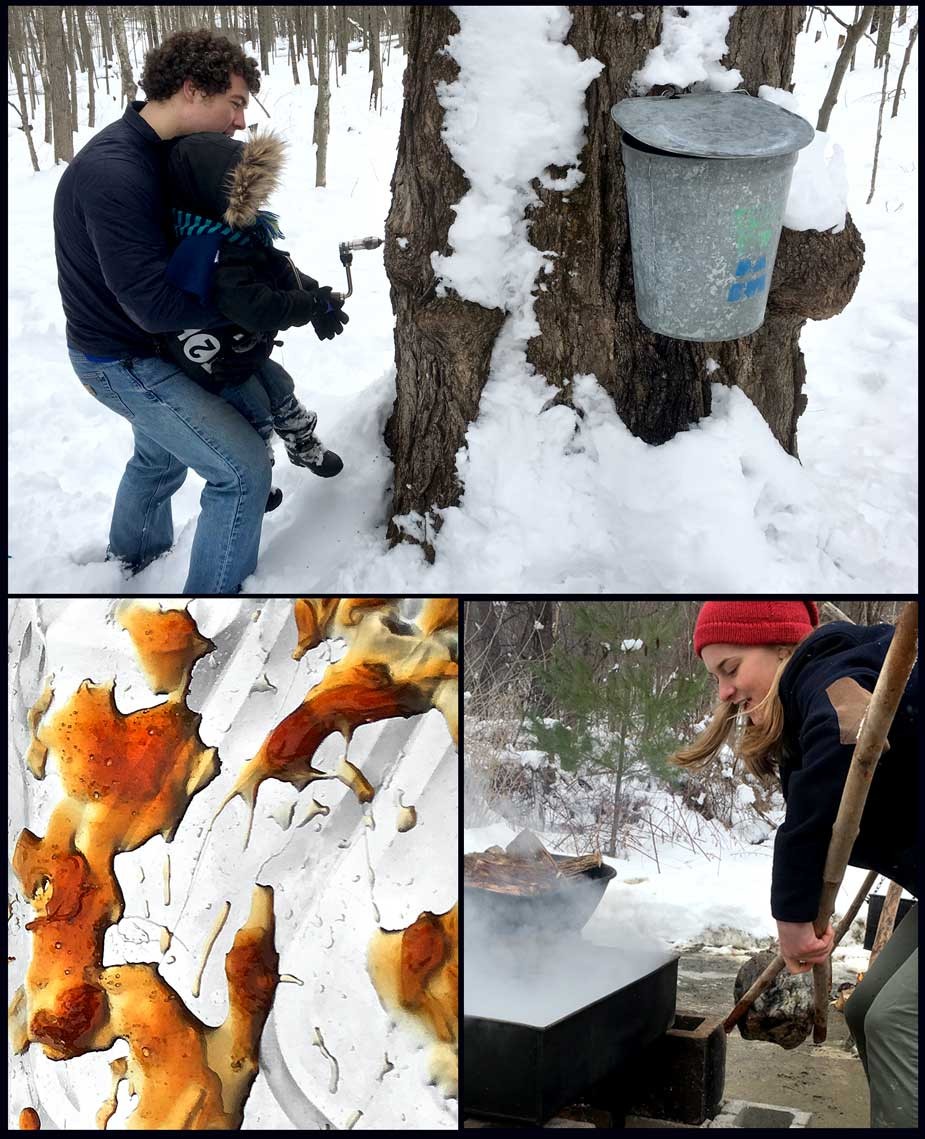 An annual harbinger of Spring, Maple Fest was held on the grounds of the 2600-acre Hopkins Memorial Forest located in Williamstown, MA on Saturday, March 10, 2018. The educational and fun event gave visitors the opportunity to experience the collection of maple sap, to its' being boiled down in a sugar shack to make maple syrup and the experience of tasting it as pure candy solidified after being drizzled onto fresh snow. Top: a young visitor holding a drill is guided by a Williams College student in tapping a sugar maple tree. An old-fashioned metal bucket at right is still used, with 40-50 gallons of sap collected and boiled down to make one gallon of syrup. Left: Amber, crystalline maple syrup is left behind on the bottom of a foil sheet that once held packed snow. Right: Historic evaporation methods to boil down maple sap were demonstrated, with another Williams student carefully maneuvering a hot rock taken from coals that would be transferred to a hollowed-out log- the method Native Americans first used to turn sap into syrup. All: David Spencer for PhotoSeed Archive
An annual harbinger of Spring, Maple Fest was held on the grounds of the 2600-acre Hopkins Memorial Forest located in Williamstown, MA on Saturday, March 10, 2018. The educational and fun event gave visitors the opportunity to experience the collection of maple sap, to its' being boiled down in a sugar shack to make maple syrup and the experience of tasting it as pure candy solidified after being drizzled onto fresh snow. Top: a young visitor holding a drill is guided by a Williams College student in tapping a sugar maple tree. An old-fashioned metal bucket at right is still used, with 40-50 gallons of sap collected and boiled down to make one gallon of syrup. Left: Amber, crystalline maple syrup is left behind on the bottom of a foil sheet that once held packed snow. Right: Historic evaporation methods to boil down maple sap were demonstrated, with another Williams student carefully maneuvering a hot rock taken from coals that would be transferred to a hollowed-out log- the method Native Americans first used to turn sap into syrup. All: David Spencer for PhotoSeed Archive
1. Eben Holden: Chapter VIII: Boston, Lothrop Publishing Company: 1903: p. 95